
































 Catalina Mihu, Editor-in-chief
Catalina Mihu, Editor-in-chief
Your commments or suggestions are always appreciated: e-mail: mihu@foodmultimedia.de
The European Parliament passed the EU AI Act on March 13, with 523 votes in favor and 46 against. It is the world’s first legislation governing the fast-growing field of Artificial Intelligence, and it aims to establish a “humancentric AI”, as the press conference following the plenary vote underscored. According to the new regulation, AI systems used in the EU must be safe, transparent, traceable, non-discriminatory and environmentally friendly. Moreover, AI systems should be overseen by people, rather than by automation, to prevent harmful outcomes.
A connection to Asimov’s sci-fi laws is hard to miss here, with a shared approach to ensuring human safety. In the real-life spring of 2024, this regulatory green light means that “AI systems posing unacceptable risks” will be banned in six months from this date. Nine months from now, codes of practice will apply, followed by having general-purpose AI systems comply with transparency requirements by this time next year. ‘High-risk systems’ will have 36 months to comply with the requirements.
The classification makes some necessary differentiations. The highest threat comes from AI deemed to pose ‘unnaceptable risks’. These include AI systems that enable “cognitive behavioral manipulation of people of vulnerable groups”, “social scoring” (classifying people based on certain characteristics), biometric identification/categorization of people, and real-time and remote biometric identification systems, such as facial recognition. Transparency is also a requirement, according to the new law. Generative AI, such as the ubiquitous ChatGPT, although not classified as high-risk, must comply with transparency and copyright laws – the content must contain an ‘AI-generated’ disclosure and the AI System must be designed with a lock on generating illegal content.
Interesting conversations are sure to build around AI applications in bakery, as innovations aim to bring us ever closer to fully-automated, smart factories. There is no doubt that bakery manufacturing can benefit immensely from integrating AI systems. Automation is already a stringent necessity, especially given the lack of workers in the production plants. And, for the people who are already there, the technology must remain human-centric, while providing any benefits required, related to making the process easier, perfectly consistent and safe, with excellent results. The field promises effective new developments, and the conversation remains open.
Catalina Mihu
12

At the beginning of 2024, the Polish industrial bakery NOWEL opened its new production facility near Warsaw. More than EUR 200 million is to be invested in the plant by the final expansion stage. 06
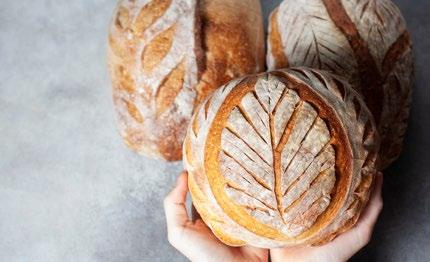
16
Precision mixing technology brings undeniable benefits to consistently forming dough exactly as needed, time after time. When choosing the best equipment to perfect the process, technologies for batch and continuous mixing can bring the best-suited functionalities for each product range, manufacturing plant and operation. ©
OPTIMUM PROCESSING, EUROPEAN DIVERSITY
No two sourdoughs are the same; its value lies in its diversity. Perfecting different sourdough specialties relies on process accuracy and stability, with optimum kneading and mixing parameters for each type of product. ©

Georg Heberer has been President of AIBI since 2022.
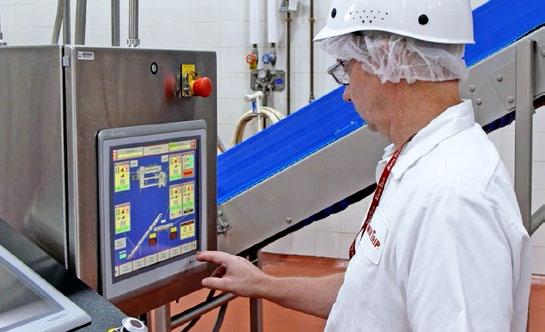
Fully automating kneading and mixing is an ambitious endeavor, given the complexity of the process, and the diversity of raw ingredients. However, bakeries now have the solutions to make major strides in this direction, for improved product consistency and to alleviate growing staff shortages.

GETTING A GOOD GRASP OF CHOCOLATE
Read the interview with baking+biscuit international. ©
Chocolate coating is a tasty addition to bakery goods, but it also creates challenges when handling compounds in the manufacturing process.
BAKERIES
06 NOWEL, Poland: Big changes rely on big decisions
KNEADING AND MIXING
12 VMI: Mulling over mixing? Benefits in batch and continuous mixing
16 Reading Bakery Systems: A fully-automated flow
SOURDOUGH
18 DIOSNA: Optimum process for a world of sourdoughs
24 Puratos: “All sourdoughs harbor a different consortium of micro-organisms” – Interview with Karl de Smedt, sourdough librarian
BREAKFAST SPECIALTIES
28 Anton Paar, Buhler: Quick characterization of waffle flours
INTERVIEW
34 Georg Heberer, AIBI President: “The functioning of AIBI is a shared responsibility of our industry”
CHOCOLATE, PART II
40 AAK: Getting a good grasp of chocolate
49 Dawn Foods: The US enjoys European-style chocolate
SCIENCE
44 ttz Bremerhaven: Microscopy – take a closer look at your products, they are worth it!
50 Grainar: Spelt – An ancient grain with a bright future
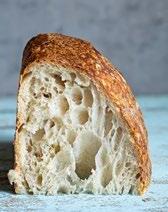

Our specialist journal concentrating on production professionals in large companies in the industrial and chain-store sectors.
Published six times a year in the English language.
Our Review series provides in-depth analysis of clearly defined issues. This involves market analyses and is a comprehensive, informative presentation of the state of the art in process engineering.


The f2m dictionary translates bakery terms into a mulitude of different languages.



At the beginning of 2024, the Polish industrial bakery NOWEL opened its new production facility near Warsaw. More than EUR 200 million is to be invested in the plant by the final expansion stage.
bbi: You produce frozen baked goods, some of which are non-branded products for baking stations, as well as ranges in the clean label, organic and artisan segments, where products are left to rest for more than 12 hours. You also make packaged goods for the end consumer market under the ‘Home Bakery’ brand. What and how much of this goes to the domestic market?
Elzbieta Zajezierska: A lot has happened in terms of production volumes since 2020. We now produce around 400 tonnes of baked goods every day. Of this, 70% goes to supermarkets, discounters and petrol stations throughout Poland. The remaining 30% goes to our partners in international markets. These are both basic products in our range –bread rolls, ciabattas, as well as premium bread with various ingredients, usually baked in a stone belt oven. A growing category – both in Poland and the rest of Europe – is snacks. Europeans have taken a liking to quick but tasty and healthy meals on the way to work or on the move. A sales hit in neighborhood shops or petrol stations in Poland are hot dogs, for which we also produce buns in various varieties and supply them to the largest chains operating in Europe. ‘Home Bakery’ was a short-term project that we launched in response to demand during the COVID-19 pandemic. We have already discontinued the concept.
bbi: You export to more than 30 countries. Were there any significant shifts in ranks during the pandemic? And what do exports look like today?
“We now produce around 400 tonnes of frozen baked goods every day. Of this, 70% goes to supermarkets, discounters and petrol stations throughout Poland. We supply the remaining 30% to our partners in international markets.”
Elżbieta Zajezierska, President of the Board, NOWEL
Karolina Zajezierska: There have been several global events in recent years that have affected us as consumers and consequently all producers, not just food producers, had to adapt to these changes. The COVID-19 pandemic, the outbreak of the war in Ukraine, global inflation and economic challenges have significantly altered the capacity of consumers’ wallets, their approach to budget management and redefined their priorities. Today, Europeans are much more careful with their spending when shopping, including basic purchases such as bread. Compared to the past, they are more likely to choose to buy bread in a supermarket or a discounter because they appreciate its quality, and enjoy a very wide range of choices with a high degree of availability. Studies show that there is a large group of customers who have, until recently, bought their bread from smaller, artisan bakeries – which were often four to five times more expensive than their competitors – and who are now shifting their purchases in favor of retail chains. We see this as a
horizontal shift in sales. This group of consumers is oriented towards price reduction.
On the other hand, we also see a vertical shift, which brings wealthy consumers who used to shop at high-end artisanal bakeries to look for everyday alternatives in the discounters. As a result, this makes the premium category in bake-off stations grow despite the general inflationary pressure. Another trend we are observing is that consumers can no longer afford as many luxury products as they used to and are therefore looking for pleasure in their food. Bread became one of the categories that lifted the consumer’s spirit, opening a wide path for product innovation. In other words, from the consumer's point of view: “Maybe we cannot afford long-distance holidays as often as before; but, we can compensate for it with great, savory, crunchy, sourdough bread. And we can have it daily.”
bbi: At the beginning of this year, you opened your new production facility in Nowy Modlin near Warsaw. What will be produced there and for which markets?
Michał Zajezierski: We will continue with the bread range and products that have been successful in our current location. We will not, however, simply duplicate the existing technology, but, as always, strive for innovation and unique solutions. It is a bit of a paradox because, most of the time, in order to really make a difference on the market, you have to take risks with prototypes. Big changes require big decisions, but, at the same time, quality results from small, harmoniously coordinated details.
bbi: More than EUR 200 million will be invested in the plant over the coming years. What does the production facility look like today and what will the final expansion stage bring?
Michał Zajezierski: It is an ultra-modern bakery that will ultimately allow us to double our current production capacity and launch new products. We have planned the site in such a way that we will be able to commission additional production lines as required over the next few years. For us, it is a very important moment in the company’s development. We have been developing an existing plant for almost 15 years, making it one of the most modern in Europe. We have meticulously planned the new site from scratch, designing every element in such a way that our work will be even more efficient, safer and give us new possibilities in the future.
bbi: Inflation, wars and weakening purchasing power in many countries – is demand falling or shifting in the markets you serve? Is there pressure on prices? And, if so, how are you reacting to this?
Elzbieta Zajezierska: As already mentioned, we are observing both horizontal and vertical shifts in consumer behavior as a result of inflationary pressure. This translates into a growing demand for bake-off products. Some events influence the demand more abruptly but short-term (like

NOWEL produces frozen bakery products (breads, small baked goods) for the bake-off sector at two plants in Legionowo (around 30 kilometers from the Polish capital Warsaw) and in Nowy Modlin (near Warsaw). In addition to leading Polish retailers, the wholesale baker supplies food retailers and discounters in other European countries such as the Netherlands, Germany, the Czech Republic and Hungary. Other export markets are the USA and Canada.
The export share is around 30 %. With around 500 employees, NOWEL generated sales of around PLN 247 million (approx. EUR 53.25 million) in 2020, making it one of the top five bakery companies in Poland, by its own estimation. In its domestic market, NOWEL is considered the market leader in the Kaiser roll and Wachau roll segment (stamped bread rolls) as well as in some mixed and wholemeal breads. NOWEL is majority-owned by the Zajezierski family. The owner family includes Elżbieta Zajezierska (President of NOWEL Sp. z o.o., pictured in the middle above), Michał Zajezierski (Vice President) and Karolina Zajezierska (Commercial Director). The Polish investor Credit Value Investments (CVI) holds less than 30 %.

the war in Ukraine) and some have more of a long-term effect, such as inflation. We appreciate that our main commercial partners, retail chains, try their best to keep the products as affordable as possible for the end consumer. And we have every intention of participating in that process. That is why we do our best to close long-term commodity contracts while, at the same time, leaving space for spot purchases that can help balance out the final price of the raw material. This difficult time has also shown us how important it is to work hand in hand with reliable partners on both ends of the process. Being challenged by the market so many times in the past years, all the participants understood that we really should work as one team. Looking for solutions together helps us to satisfy the end consumer, grow the business and support the economy in surviving the turmoil. However, unfortunately, this does not mean that the yearly negotiations have gotten any easier.
bbi: You now run two production sites. How is production distributed between the two sites? How much of it is bread, compared to small baked goods (such as bread rolls), and breakfast pastries such as croissants? What about pastries and cakes?
Michał Zajezierski: Currently, in both plants, we focus on bread products including rolls, breads, baguettes, premium products and hot dog buns. In Legionowo, we do not currently produce pastries, but we are not excluding this range from our future investments.
bbi: To what extent is the new plant already automated and digitized? What is the timetable for this?
Michał Zajezierski: Compared to Legionowo, we went even further with automatization in our new plant in Nowy Modlin. We have introduced a number of new solutions, particularly in the area of raw material supply, but also in production, that will result in even better quality products. Some of these solutions are unique for the bakery industry. NOWEL will be the first bakery to use them in industrial production.
As far as digitalization is concerned, the new plant will be supplied with a new, state-of-the-art, digital managing system, that will allow us to control every detail of our manufacturing process online, in real-time.
bbi: What is the status of the other plant, in this regard?
Michał Zajezierski: Our other plant in Legionowo is already highly automatized. We use fully automatic lines, which also feature automatized multi-step fermentation processes and robotized mixing solutions. In this regard, it is one of the most highly automated production facilities in Europe.
“At our new plant near Warsaw, we have introduced a number of new solutions, not only in the area of raw material supply, but also in production, that will result in even better quality products. Some of those solutions are unique for the bakery industry.”
Michał Zajezierski, Vice President of the Board, NOWEL
bbi: You want to create 800 new jobs in the new plant. Is it a problem to find qualified personnel for this?
Karolina Zajezierska: Ultimately, the new plant will have up to 800 employees. The recruitment of personnel for the first part of the investment started a few months ago. Nowadays, building and maintaining qualified teams is, obviously, a big challenge, not only in Poland. All of Europe is facing it. Today, a modern bakery is a place where every process is automated, digitized and only supervised by qualified staff. In our company, we have developed a system of staff training programs and skills development in various areas. NOWEL employs representatives of several generations of families. The oldest ones, who have been with us for more than 30 years, remember our beginnings in cooperation with retail chains, which were just starting to appear in Poland at that time. Their children have joined our company at a time when the processes were being automated. We believe that we can be an interesting alternative for many young people in the labor market. We combine tradition and craftsmanship with modernity and have 100 years of experience in this.
bbi: What can you tell us about energy efficiency and the issue of sustainability not only in regard to the new plant, but also the company as a whole?
Michał Zajezierski: Sustainability is one of the key drivers for our current operations and future development. The plant in Legionowo is already using multiple solutions that use recovered energy or heat in various processes. NOWEL is also in the process of building a solar power plant that will supply approximately 30% of the electrical energy needs for the Legionowo site. We draw the rest of our electricity requirements from a combined heat and power plant operated by the city of Legionowo, which supplies the city with thermal energy and hot water and delivers electricity to local companies, including NOWEL.
Our new plant was designed using all available technologies to lower its carbon footprint and prepare it to become
carbon neutral. We will use heat pumps, solar power plants, electric trucks, and other solutions from the first day of the bakery’s operation. NOWEL is also cooperating closely with production line manufacturers on new developments that will make the production process more energy-efficient.
bbi: Until recently, you have primarily been a supplier to food retailers and the catering trade. At the end of the year 2022, you went directly to the end consumer market with two sales bistros in Warsaw. Will the bistros be operated by a separate company from NOWEL?
Karolina Zajezierska: The concept is formally part of the parent company NOWEL. It is merely another department in the company structure.
bbi: Can you tell us more about the idea behind this concept, will it remain limited to Poland? Or do you want to roll it out internationally, for example, in large cities or at the airports?
Karolina Zajezierska: In a way, history has come full circle. My great-grandfather, who started everything in our family bakery, was baking bread at night to sell early in the morning to neighbors and friends heading to work. This contact with people, relationships, conversations, hustle and bustle in our home bakery was significant and was engaging the
next generations; thanks to this, we were able to grow. Now, we are returning to this atmosphere and direct contact with customers with our brand “Żywioły Bread&Bistro” (Elements Bread&Bistro). At the end of 2022, a flagship location was created in the center of Warsaw – in an iconic and well-known store, Dom Towarowy Braci Jabłkowskich (Jabłkowski Brothers Department Store). It is a combination of a restaurant and a deli, and the so-called heart of our brand. A chef prepares seasonal dishes; you can enjoy time with family or friends, and buy fresh bread or sweets on the way out. At our second location, we bake bread and rolls on-site. There is also a large selection of sandwiches, cakes and snacks for sale. We are currently working on other locations in and around Warsaw. We want to open at least a few new bistros in 2024. It should become a nationwide concept. We are monitoring the market situation in Poland’s largest cities. That’s where we see the growth potential for our concept.
bbi: Could you give us a brief insight into the Polish bakery market? How is the market developing? How does it differ from the bakery markets in Western Europe, for example?
Karolina Zajezierska: Certainly, the Polish bakery market is comparable to the markets of Western Europe. Apart








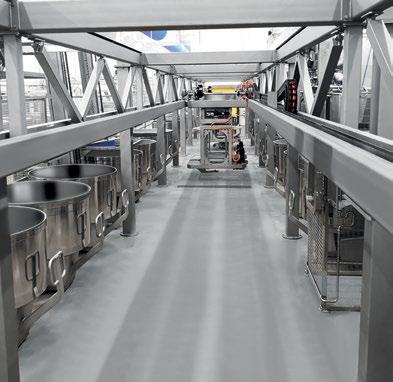



from local conditions resulting from culture or tradition, we see many similarities both in terms of consumer trends and leading categories. Poland’s baked goods market size is growing in value. According to Noble Fund, the size value of the frozen baked goods market in the country amounts to approximately PLN 3.5 billion. According to the Central Statistical Office (GUS), in 2022, the entire baked goods market in Poland was worth more than PLN 14 billion.
Poles, like other Europeans, buy bakery products mainly in hyper- and supermarket chains. The share of frozen baked goods in total on the market is still quite smaller than, for example, in Germany or France; but, we predict that the share will grow year-on-year.
Still, not all retail chains in the country have invested in the frozen goods baking infrastructure, although it seems to be only a matter of time. As in the rest of Europe, consumer’s interest in premium baked goods has been growing in Poland in recent years. They are paying particular attention to the quality of raw materials, clean labels and taste. It is also an extremely competitive market because, historically, bread has always been perceived as cheap and affordable in Poland. That is why, in European statistics, the price per kilo of bread in Poland is one of the lowest in the region, even after inflation. Also, there are many good and reputable producers who operate on the market with large-scale production as well as thousands of medium-scale bakers, so one really needs to have a good strategy to grow.
bbi: What about the competition from muesli, porridge, and the like?
Karolina Zajezierska: These products are, of course, competing for their place on the consumer’s table, but we prefer to focus on product development strategies that result in quality, for which demand is growing.
bbi: Over the past 20 to 30 years, a number of industrial baked goods manufacturers have emerged in Poland, some as subsidiaries of international groups that primarily

“The share of frozen baked goods in the total market in Poland is still smaller than, for example, in Germany or France, but we predict that it will grow year on year.”
Karolina Zajezierska, Vice President of the Board, NOWEL
serve the export market. Who serves the Polish market today: the artisan sector or does the business primarily run via food retailers and therefore industrial manufacturers?
Karolina Zajezierska: Many good and reputable producers operate on the market with large-scale production and they mainly work with retailers, although some specialize in the HoReCa segment and also develop their individual distribution channels on the so-called traditional market –privately owned stores, smaller supermarkets, etc. Mediumscale bakers also work as fresh distributors with some retailers, although their primary distribution goes through their own bakery outlets. The market, especially in large cities gives room for artisanal bakeries to thrive, but, they are usually single-point, local-scale businesses.
bbi: Are bakery products in Poland today mainly eaten at home or in the catering trade, in cafés, bistros, or fast food outlets?
Karolina Zajezierska: As a result of the pandemic, many Europeans have scaled back going out to restaurants or bars, in favor of eating at home. Many studies even speak of a ‘generation of hermits’ who, as a result of the COVID-19 pandemic, have been holed up at home, work remotely, do most of their shopping online and use public transport less frequently. The service industry has certainly suffered from it, with far fewer users than before the pandemic. In Poland, bread is a basic product. It is served at virtually every breakfast, dinner, as a snack, or as a nutritious meal at different points of sale. +++
American Pan understands the importance of finding the right pan for your bakery’s unique products and needs. Our team of experts can design an innovative solution tailored for your bakery, offering a variety of materials and pan strengthening features, as well as:
• Sizes & Arrangements: Customize your overall pan size, cavity arrangements, and dimensions.
• Cavity Designs: Choose a standard croissant cavity or create a unique design for signature products.
• Coatings: Select one of our world-class, proprietary coatings, designed to aid in the easy release of a variety of dough formulas.
Want to prolong the life of your bakeware? Your pans can be cleaned, recoated, and returned to your operation like-new with our bakeware refurbishment services.



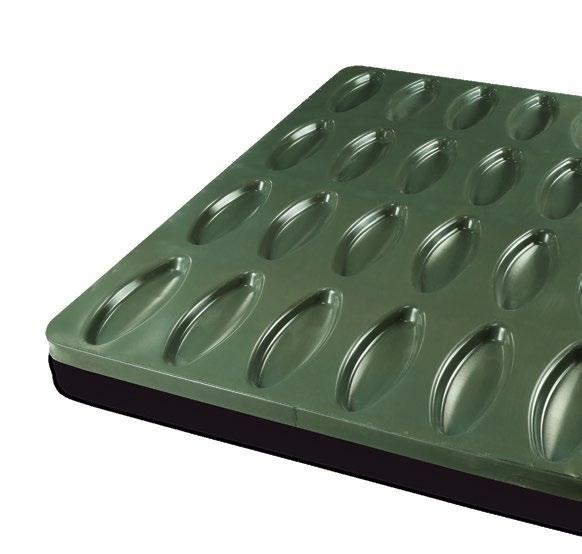



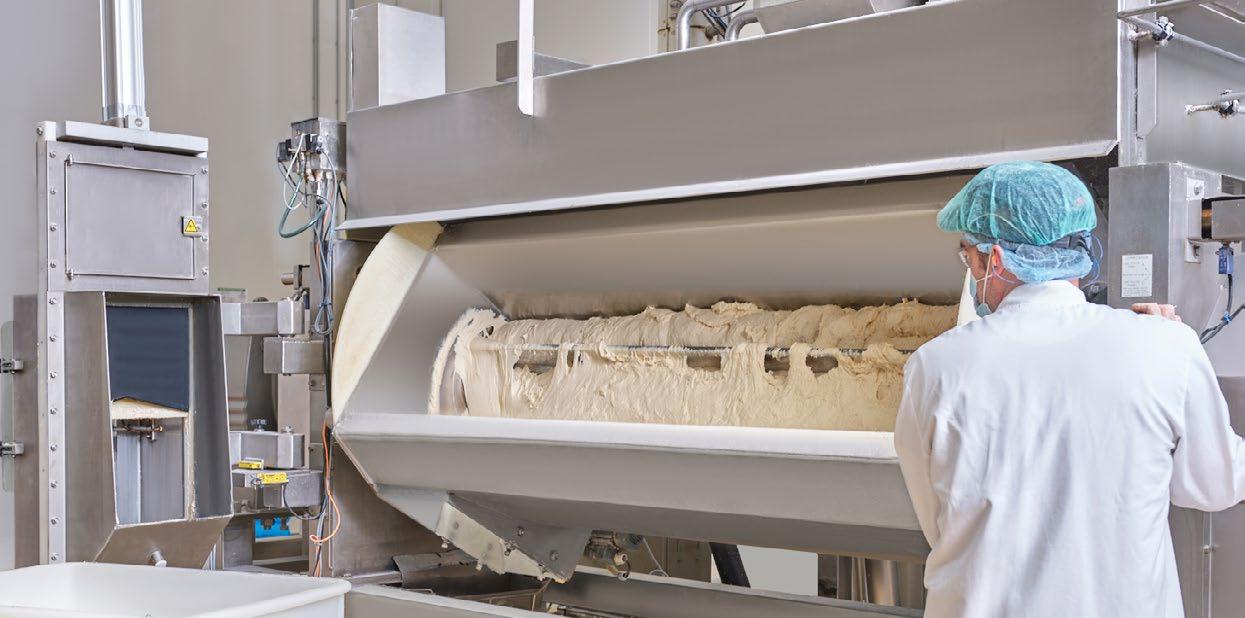
Precision mixing technology brings undeniable benefits to consistently forming dough exactly as needed, time after time. When choosing the optimum equipment to perfect the process, technologies for batch and continuous mixing can bring the best-suited functionalities for each product range, manufacturing plant and operation.
+Continuous or batch mixers? The answer is not a simple, linear, ‘either/or’ choice, when choosing the best fit for a range of products, a production line – or several, a baking facility, or a network. There is a strong case that justifies each, in any given (baking) circumstance.
Continuous mixing machines excel in delivering consistent results. They are the technology of choice for forming raw, par-baked and frozen dough, and are not only often seen in the production of bread and baguettes but also puff pastry, and Viennese pastry, where their cooling capacity is especially beneficial. “Continuous mixers, such as our Verymix, are valued for their ability to ensure consistency and stability in single-product operations,” VMI elaborates.
However, their versatility extends further, considering that various technologies are perfected for continuous mixing. For instance, continuous vacuum mixers, such as VMI’s Continuum range, can also be used to process dough for soft products such as sandwich breads. Further developments are underway: “We are also exploring new applications with the Continuum, such as biscuit/cookie production,” VMI highlights – although there are several established reasons why batch mixing remains the traditional choice in segments such as biscuits and cookies.
One key factor as to why batch mixers make sense in cookie production is the nature of the dough, which tends to be less structured compared to bread dough, for instance. Continuous mixing systems need to work with dough that is well-bound for peak performance that facilitates smooth
circulation within the mixing tank. However, it is possible to use a continuous mixing technology to make biscuits and cookies, VMI believes; several successful trials have already confirmed the hypothesis.
“Batch mixers with removable bowls also excel in the efficient management of the different dough processing phases, such as resting periods and autolysis.”
VMI specialists
Another reason why batch mixers are a tried and tested, valid choice for these applications is the flexibility they offer for recipe changeovers. Batch mixers with removable bowls are especially well-suited for fast handling, making them a widely popular choice, particularly for the production of biscuits and cookies: “One key aspect is the ease of changing production setups, allowing for quick transitions between different products. When considering batch mixers, there are various configurations available, including automated, semi-automated, or manual configurations. This allows for adaptation of the process to meet the customer's needs, budget, and desired level of flexibility,” VMI illustrates. Batch mixers with removable bowls also excel in the efficient management of the different dough processing phases, such as resting periods and autolysis. “This versatility empowers producers to customize their processes according to specific recipes or production requirements,” the French specialist explains.
Looking at their different needs in terms of teams, resources and end products, continuous mixing will require a learning curve for the staff when first adopted, as it is not yet as widely used as batch mixing. However, it is a highly efficient technology once assimilated. Moreover, it is nimble regarding resource requirements, with most processes being automated. Batch mixing systems, by contrast, define the level of resources needed to operate according to their level of automation in the line: manual systems need substantial resources, while fully automated setups have considerably lower needs.
The end product manufactured plays a decisive role in the choice of mixing technology. It should be noted, however, that there is no one-size-fits-all solution in this regard, even if certain technologies may be recommended for specific products. The choice of the technology to use largely depends on the operation’s requirements, the desired quality of the dough, and the characteristics of the end product.
Comparing the mixing process for batch and continuous mixers is a challenging enterprise, even when looking at similar production volumes and products, as it can vary significantly on each production floor. Several parameters may differ, including the volume of the mixer, the number of bowls, the automation level and mixing tools, for example. “But, it is entirely possible to present two offers to the same customer for the same product and requirements – one using batch mixers and the other using continuous mixers,” VMI underlines. The specific needs and priorities of each operation will determine the technology of choice.
Among factors that often steer the choice towards continuous mixers, VMI observes:
+ The need for high-level stability and regularity in dosing ingredients, that minimizes the risk of human error and ensures product uniformity;
+ Consistency in product quality;
+ Easy operation with precise dosing and a highly regular output;
+ Cooling capacity: continuous mixers can cool the dough during the process due to the large contact zone between the dough and the double-jacketed tank with glycol circulation.
Alternatively, factors that favor the choice of batch mixers usually include:
+ Batch mixers offer greater flexibility, allowing for easy adjustments in production setup, especially when producing a large range of products;
+ Automated systems with batch mixers can be equipped with Clean-in-Place (CIP) systems, simplifying the cleaning process of the bowl;
+ They can handle a wide array of different ingredients,
accommodating a diverse range of products. On continuous mixers, since dosing is automated, a dosing unit will be needed for each ingredient in the recipe, even minor ingredients, which brings additional cost- and space-related considerations into the equation;
+ Most batch mixers only limit dough heating, they do not cool the dough – only some models offer this feature.
However, there is no major difference in terms of productivity or production rate as this will entirely depend on the process and equipment chosen, the French specialist highlights.
Cleaning and maintenance will also vary for each type of technology. Continuous mixers like the Verymix offer a mobile Clean-in-Place (CIP) system that allows the liquid dosing units to be cleaned efficiently. The tank requires manual cleaning, but the stainless steel bowl is easy to clean. Additionally, continuous mixers have minimal wearing parts, making maintenance straightforward.
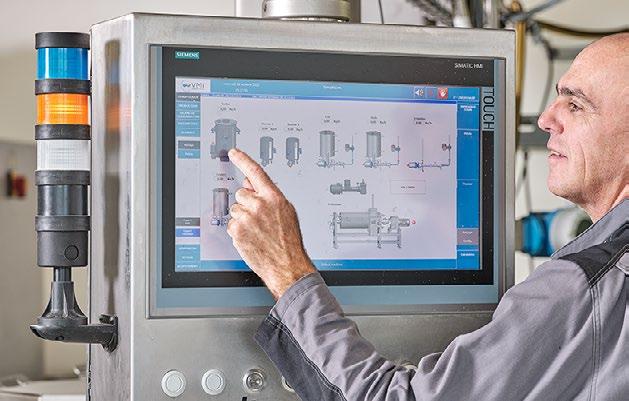
Automated batch mixing systems, on the other hand, may include CIP to clean the bowls, streamlining cleaning processes. However, cleaning mixing tools manually might still be necessary for recipe changes, VMI observes. Maintenance will depend on the specific technology and the process (i.e., the type of dough, mixing duration, etc.).
Looking at the bigger picture, the production facility itself and its setup should also be carefully considered when choosing a mixing technology, VMI recommends: “Batch mixers with removable bowls offer flexibility, especially in semi-automated setups, making them adaptable to various environmental constraints. They integrate well into existing workflows and allow for easy scalability by adding more mixers to increase production capacity. Conversely, the compactness of continuous mixers depends on the recipe and the number of dosing units required. Recipes with numerous ingredients, such as Viennese pastry, may require many dosing units, affecting the system's footprint.”
Continuous mixing is particularly adapted and often highly efficient for single-product productions. However, when manufacturers decide on new investments, they may hesitate to opt for this technology, VMI observes, even in cases where it appears to be more beneficial than batch mixing. Unfamiliarity with the technology is often the underlying cause: “For example, production teams might hesitate to switch from batch mixing to continuous mixing due to the potential disruption of their working habits and familiar manufacturing practices, despite the ultimate efficiency of the solution. This underscores the crucial need for dedicated support throughout the transition process,” VMI explains.
Without a doubt, continuous mixing technology is surging in popularity. Consequently, it is also expanding into new applications, a prime example being in the production of donuts. “This technology offers unparalleled consistency and is especially efficient for products that require careful fermentation control,” VMI concludes.
Process control is paramount to ensuring consistent results, for any production setup. Both batch and continuous mixing technologies can incorporate process controls through Human-Machine Interface (HMI) systems. However, continuous mixers often offer more precise and comprehensive control as they fully automate the process, from dosing to pre-mixing and mixing. In this way, consistency and accuracy are ensured throughout the entire mixing process.
Mondelēz International launched its fifth annual global consumer trends study, called State of Snacking™. The report, developed in partnership with The Harris Poll, reveals that amidst ongoing global economic uncertainty, consumers continue to prioritize, purchase and prefer snacks. The past half-decade of tracking attitudes and behaviors among thousands of consumers across 12 countries has shown a consistent trendline of consumers demonstrating a preference for snacks over meals. Snacking behaviors continue to


In turn, batch mixers may also feature advanced process controls, especially when looking at automated systems, which allow precise monitoring and adjustment of parameters; process control capabilities will largely depend on the level of automation in the line, in this case. “When batch mixing systems are not fully automated, it is common for the dosing part to be separated from the main system. This means that the dosing control may not be integrated into the batch mixing system itself, leading to potential variations in ingredient proportions,” VMI illustrates.
It is a complex decision-making process, with many variables to be taken into consideration. However, the goal of achieving high-end results remains constant. +++
grow, including notable growth in mindful snacking, with the chocolate category in particular closely associated with joy.

Mondelēz also debuted a stand-alone, complementary State of Snacking: Future Trends report this year, showcasing longer-term consumer macro trends shaping the future of snacking. Both are available for download. The macro trends analyzed include: shifting demographic landscape, increasingly fluid lifestyles, people and planet impact imperative, health and wellbeing ubiquity, and resurgence of experience economy. These macro trends provide additional context on changing behaviors from a big-picture perspective, further exploring how the snacking world may evolve in the future. +++
Closing up to 120 bags per minute with state-of-the-art motion control, ethernet, and wireless communications, the speedy 893 C Automatic Bag Closing Machine has efficiency baked right in. LEARN MORE AT KWIKLOK.COM























































Fully automating kneading and mixing is an ambitious endeavor, given the complexity of the process, and the diversity of raw ingredients. However, bakeries now have the solutions to make major strides in this direction, for improved product consistency and to alleviate growing staff shortages.

+Reading Bakery Systems (RBS) has fully automated the mixing process wth their continuous mixing systems. The ultimate goal is to have systems running independently, without any need for staff intervention. And, while mixing may be among the most complex manufacturing processes in a bakery, today’s mixing technology is very close to this goal. “This is because, complex as it may be, the process consists of sequenced, measurable and controllable steps. Not only are the latest mixers controllable, but the control packages are rich in data to demonstrate the process is repeatable,” specialists from RBS emphasize. Integrated controls can already address decision points instead of an operator who requires training and experience. With fully automated mixers, “Quality and consistency are confirmed at the beginning of the baking process and not at the end of the process,” they add. Continuous mixing systems can take input from other parts of the line, such as hopper levels, operation status of downstream equipment, and data inputs such as temperature, and use it to automatically adjust the mixing system parameters to assure consistent production and product quality.
Bulk handling is a similar process for continuous and batch mixers, throughout every step of the mixing process:
+ Dosing: The benefit of automated continuous mixing is that the accuracy of the recipe is guaranteed, at any given moment of the day, or season. “The dosing by metering equipment is critical to this step. It is important that gravimetric metering, not volumetric is used, to guarantee the high degree of accuracy needed. Loss-in-weight feeders are used for powders and pump and flow meters are used for liquid ingredients,” RBS explains. Solid fats, or delicate components (berries, for example) require more specialized equipment.
+ Mixing: RBS has been perfecting specialty mixers based on the premise that no single mixer can be used to make
all kinds of bakery products. This is why the American specialist offers five types of continuous mixers, each in 4 to 6 sizes, for different production volumes. The different models vary in shear applied, energy input, mixing properties, and other design factors. Selecting the correct type of mixer for specific products is the key to perfecting automated production.
+ Discharge: Managing dough discharge from batch mixing can be a challenge; by contrast, this is not the case for continuous mixers. The dough exits the mixer in a ‘log’ or a steady stream of dough. “A knife at the discharge of the mixer cuts the log into manageable-sized pieces, so that they are suitable for transport on a belt. This dough can then go directly into the downstream forming equipment, eliminating the large dough handling equipment needed after the batch mixer to cut the dough into smaller, usable pieces.
“With fully automated mixers, quality and consistency are confirmed at the beginning of the baking process and not at the end of the process.”
Reading Bakery Systems specialists
Process monitoring is instrumental in automating the mixing process. It enables the mixing system to make automatic adjustments that account for variations outside of the mixing scope. It outlines process variables, highlighting constant values and less stable parameters, for a deeper understanding of the process that supports further advancements. “Instantaneous variations should be ¼% for liquids and ½% for dries or less. Typically, a variation of more than ½% for more than 5 seconds will create an alarm for the operator.
However, the system is self-correcting and these alarms are rare after commissioning,” RBS explains.
The actual variation required to define an alarm is an adjustable input. Usually, three levels of alarms can be set, with timings that are preset by RBS during commissioning:
+ Level 1: The parameter moves out of range. The system begins to self-correct.
+ Level 2: If the system has not self-corrected within the time selected by the operation (usually 5 seconds), the alarm is activated. The system continues to self-correct, or the operator can intervene.
+ Level 3: If the system has not self-corrected and the operator has not intervened after a set period of time (usually 15 seconds), the system will shut itself down until the operator restarts the system. This can occur when an ingredient cannot be metered properly (i.e., it runs out), when the processing line stops somewhere downstream, or when the hopper to the forming equipment fills up.
Automated mixing systems adjust the throughput to keep the hopper at a constant fill level, using a photo eye above it. They can also stop the process altogether if they receive a signal from downstream equipment that the line has stopped working.
Process parameters that are automatically monitored during continuous mixing and recorded also include:
ingredient rates vs. process value, ingredient temperatures and finished dough temperature, all mixer parameters, work input, total throughput, and dough total since the last changeover, RBS lists. “Any process condition the bakery wants to track can be recorded and saved to a database known as trending,” the specialist explains.
Currently, with a fully automated mixing system, an operator is only needed for a few minutes every hour. Their main task is only to address the occasional alarm and to observe the dough to confirm quality. This type of solution can answer ever-increasing staff shortage issues, a driver for its adoption rate. By comparison, batch mixing remains labor intensive.
The initial investment in a continuous mixing system is higher than in batch mixing. The total cost of the latter will depend on the level of automation of the batch mixing system and the dough capacity of the line. In an estimation that also factors the reduction of labor costs, the return of investment with a continuous mixing system is usually between half a year and two years, RBS calculates. Where applicable, “The initial investment is worth it with this payback, and the additional benefits continuous mixing offers including more consistent dough, less energy usage in ovens, lower safety and food safety risk, less dough handling equipment investment and more.” +++

No two sourdoughs are the same; its value lies in its diversity. Perfecting different sourdough specialties relies on process accuracy and stability, with optimum kneading and mixing parameters for each type of product.

+To optimize sourdough processing, the best place to start is by learning the starter itself. An important characteristic of starter cultures is stability: they must be stable in terms of microbiological quantity (concentration of microorganisms) and quality (representation of the background species). The starter cultures ensure the repeatability of the fermentation and, therefore, the sourdough’s stability – which is determined by the pH and TTA parameters. Stable fermentation parameters such as temperature, time, dough yield and percentage of starter or mother sourdough also contribute to the consistency of the resulting sourdough. Working with user-friendly starter cultures also goes a long way to maintaining their stability. DIOSNA’s starter cultures, for instance, can be used as semi-solid starters, which are easy to crumble, or as liquid starters. Both can be used for artisan production as well as for industrial solutions.
A useful classification
Europe is home to a flavorful diversity of sourdoughs. General trends can be observed across the continent – for example, in Northern, Central and Eastern Europe, rye is frequently preferred, whereas wheat is used across Europe, the dough specialist observes. Niche, specialty sourdoughs are also prepared: gluten-free variations usually comprise fermented rice, buckwheat, or some mixture of starch and flours.
Rye sourdoughs can be divided into solids, which are prepared in bowls, and liquids – fermenters are used for their preparation. Stiff rye sourdoughs are more demanding in terms of preparation and space, which is why bakeries tend to prefer using liquid sourdoughs. Liquid sourdough, in turn, can be divided into active and stable sourdough. Active
“Recipes are commonly developed based on the properties that are expected of the final product, in terms of smell, taste, crumb, elasticity, volume, and other characteristics. ”
DIOSNA specialists
sourdough has a certain leavening power and requires cooling. Stable sourdoughs are characterized by a higher acidity and a long fermentation time without the need for cooling. A special stable fermentation is used for bread fermentation, for which it is possible to ferment up to 50% of the weight of the flour in the sourdough.
From a processing standpoint, rye sourdoughs can be divided into single or multi-stage fermentation. For the most part, there is a preference towards using single-step rye sourdoughs. Depending on the bakery and the region, active and stable rye sourdoughs are chosen.
Wheat pre-doughs can be divided into two groups of their own: yeast pre-dough (pre-dough), which uses yeast as a starter (examples include biga, poolish, or opara), and sourdough – for which lactic bacteria are used as a starter. Wheat pre-dough can either be stiff or pumpable. Solid pre-doughs are fermented in bowls or boxes and are more demanding in terms of preparation, handling and space. By contrast, liquid pre-doughs are prepared in fermenters –meaning that it is possible to cool them and extend their usability. “The equipment for wheat pre-dough can work according to our standard yeast pre-dough and sourdough parameters, or according to the client´s parameters if requested,” DIOSNA explains. The choice between wheat
yeast pre-dough and sourdough can vary according to the character of the product and the region’s established preferences.
Recipes are commonly developed based on the properties that are expected of the final product, in terms of smell, taste, crumb, elasticity, volume, and other characteristics. Various alternatives are available to choose from, according to how well they match these expectations: wheat sourdough, rye sourdough, or wheat yeast-pre-dough (or other scalding dough and aroma pre-dough (AromaStück®).
The product is then trialed, made with one or more pre-/ sourdoughs with different amounts of pre-dough, and evaluated. When the optimum dough recipe is identified, the corresponding pre-dough system is then calculated and designed, according to the recipe and the capacity needed by the production line (or lines).
Conveniently, sourdoughs are not partial to a specific kneading technology – they can be processed with optimum results on universal kneaders, i.e., wendel mixers, as well as spiral mixers from DIOSNA's portfolio. The choice between available options is determined by the recipe: mid-soft and soft types of dough for products such as bread, buns and ciabatta, or soft yeast doughs, both wendel and spiral kneaders are suitable choices.
For special doughs, or hard and cold doughs such as those used in pastries, or cold dough for freezers, DIOSNA recommends the wendel mixer.
To optimize kneading parameters, the correct timings are given by attributes such as:
+ The flour: wheat or rye content: wheat dough needs much more energy to develop the gluten structure
+ DY level: softer doughs need longer kneading time, while stiffer doughs need less time for the process
+ Tool(s): spiral, wendel, L-shape mixers and others; using the wendel mixer, 1/2 to 2/3 of the kneading time can be achieved compared to the spiral mixer
+ Mixing style: two gears or more steps with Frequency inverter (FI)
+ The type of dough: doughs with a higher content of sugar, eggs, fats and oxidants in the recipe need longer mixing times
+ pH: the lower the pH of dough and reductants, the shorter the kneading times
+ Dough temperature
+ Pre-dough content: using more pre-dough can result in a shorter mixing time requirement (0-10% of mixing time)
The mixing time is defined by the dosing speed of flour and water, the intensity setting of the blending process and by the kind of flour. Blending and mixing pre-/sourdough are done quickly, usually within 15 minutes after filling the fermenter (for wheat with 200 Dough Yield (DY) and rye sourdough with ≥ 220 DY). The mixing process itself is more complex for wheat flour, which must avoid creating lumps through adequate stirring. Dosing can be carried out automatically, in the fermenter, where the intended amounts of water and flour are simultaneously brought together and mixed with high intensity, or in the

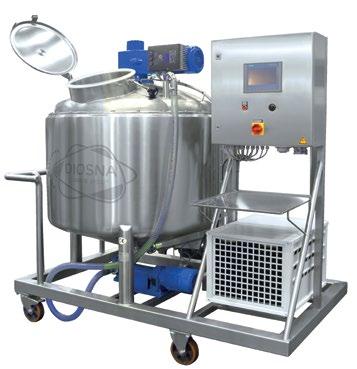

mixing pump, from where the homogenous suspension is delivered to the fermenter. Using pre-dough or sourdough can reduce the kneading time required by up to 10%, depending on the type of dough as well as the kind and amount of pre-/ sourdough. For reference (detailed in Tables 1-2), a full bowl of standard wheat dough will require 9 minutes for kneading with a DIOSNA spiral kneader: 3 minutes running at the first speed, followed by 6 minutes using the second speed. With a wendel kneader, kneading a full bowl of the same mix will require 5 minutes (1.5 for the first speed, and respectively 3.5 minutes at the second speed).
For fermentation, the ideal time is defined according to the kind of sourdough used. For example, DIOSNA’s standard fermentation times for DIOstart/yeast are the following: 42 hours for bread fermentation, 18 hours for wheat sourdough, and 4 hours for yeast wheat pre-dough. Fermentation times also vary according to the proportion of mother sourdough in the sourdough, if some is used to refresh/replicate the sourdough. Fermentation times of formulations with 5% mother dough range between 13 to 16 hours; for a ratio of 15% mother dough, the appropriate fermentation time is 7-9 hours; when 25% of the mix is mother dough, the fermentation time needed is 4-6 hours.
The optimal fermentation process is the result of the correct balance between time and temperature. To control the product temperature, fermenters have cooling or cooling/ heating units, connected to the facility’s central cooling/ heating systems. AromaStück®, for example, has a standard heating time of 3 hours at 65°C. The process is enzymatic, and no microbiological fermentation occurs.
Scalding dough has a heating time of 0.5-2 h, depending on the raw material (e.g., 0.5 h for flour, flakes; 2 h for whole grain). In this case, the main process is gelatinization.
Temperature changes, from the process and from the environment, should be accounted for. In the fermenter, the pre-dough is cooled by coming into contact with the fermenter’s surface. “The cooling time is defined by the temperature of the cooling medium, the flow of the cooling medium, the intensity of stirring and the temperature gradient between the pre-dough and cooling medium,” DIOSNA explains. Cooling may not always be required: rye bread with a long fermentation time can work well at room temperature
Table 1:
Tool Bowl Tool Bowl
Table 2:
Tool Bowl Tool Bowl
(22-26°C), without the need for cooling the fermenters, for instance.
Examples of fermentation temperatures:
+ Rye, wheat and spelt sourdough:
- At warmer guiding (> 28°C), a strong aromatic taste of the baked goods is achieved
- At colder guiding (26-28°C) high gas activity, the yeast can be reduced in this case
+ Bread fermentation:
- First stage temperature (isofermenter): 32°C
- Starting temperature: 28°C; after 16-24 h: max 32°C
+ Gluten-free sourdough
- With warmer guiding (> 32°C), the result is an aromatic, strong taste in the baked goods
- With colder guiding (28-32°C), results in a yoghurt-like taste
+ AromaStück ®: the fermentation temperature is 65°C
+ Scalding dough: the fermentation temperature is 75-85°C
The processing time of sourdough is also dependent on the storage temperature. The processing times for wheat sourdough and rye sourdough are:
+ 8 hours (without cooling)
+ 24 hours (with cooling, i.e. cooling to around 15°C after the fermentation time)
+ 48 hours (with cooling, i.e. cooling to around 10°C after fermentation)
+ 72 hours (with cooling, i.e. cooling to around 6°C after fermentation)
The processing time of wheat yeast pre-dough is shorter than that of wheat sourdough. In industrial bakery operations, the processing time of rye bread is four days – without cooling. When manufactured in a craft bakery environment, a week is required.

Would you like to know how you can sustainably save time, energy costs, and storage space in your bakery, while still ensuring high-quality laminated pastries?
We would be pleased to inform you about this.
Product properties and consistency rely on process control, which is especially important when long-term fermentation products are made, such as products made using sourdoughs. The sourdough system shares information about the current processing step (filling fermenter, fermentation, cooling, ready to use), the amount of sourdough (kg), the age of the sourdough (h), its temperature (°C), and style of blending. The most important parameters are the time and temperature of each process step.
To monitor the sourdough throughout the mixing and kneading process, the pH meter is an option, as its values provide information that can be used to evaluate the sourness of the dough. The correct time and temperature as defined by the sourdough’s recipe are controlled


automatically by the cooling (or cooling-heating) medium. The system keeps these two parameters within predefined values for each step. The result: sourdough with stable properties. +++ ©
Lesaffre and Qair, an independent renewable energy company, signed an 18-year contract for the direct purchase of renewable electricity (CPPA) from an agrivoltaic plant –a synergy between agricultural production and photovoltaic energy.
Covering a forecast annual purchase volume of around 34 GWh, this additional CPPA ensures the supply of green electricity from an agrivoltaic project developed by Qair in the Hauts-de-France region. With construction starting in 2025 and operation scheduled for 2026, the plant will avoid the equivalent of around 630 tonnes of CO 2 emissions per year, and inject 68 GWh of green electricity per year into the French power grid. +++
Koenig Group introduced a new fully automated machine for dough dividing and rounding in March 2024: the Industrie Rex V AW EC. The system has a dough throughput of 6.5 tons per hour – meaning an hourly output of up to 50,400 pieces per hour in 14-row operation, and features Koenig’s ‘Easy Clean’ design.
“With this innovation, we have built the machine of the future,” says Koenig CEO Hannes Stelzer about the new development. The new Industrie Rex V AW EC is the most powerful machine to date in Koenig’s portfolio in this equipment category. It handles weights ranging from 22 to 180g, with a weight accuracy of +/-1%, depending on the dough.

AAK and Checkerspot are joining forces to develop, scale, and commercially produce an alternative source of structuring fats and oils. As consumers and global brands continue to push for new plant-based options, developments for new fats and oils need to meet three criteria: they can be produced at scale, provide unique consumer experience, and are less vulnerable to climate change, Checkerspot highlights in an announcement.
“Checkerspot’s growing portfolio of unique oils and their expertise in microalgae fermentation make them the ideal partner for us to collaborate with to meet the growing demand for alternatives that are both functional and sustainable,” said Kim Olofsson, Global Head of R&D at AAK. +++

2100 lines installed worldwide and we are always around the corner.

Tasteable quality secured by over 85 subsidiaries worldwide

“All sourdoughs
a different consortium of micro-organisms”
With a unique culture and a longstanding tradition, sourdough is used in new interpretations for unique creations. Karl de Smedt, sourdough librarian at Puratos, shares insights into the bustling scene of European sourdough creations, how to maintain a strain’s profile and how to work with sourdough in large-scale operations.
+Catalina Mihu: What is an overview of the sourdough diversity in Europe, and the products traditionally made with them, in certain countries?
Karl de Smedt: To date, there have been no comprehensive studies of how sourdoughs vary between different countries throughout Europe, but we do know some demographics prefer certain sourdough flavor profiles. Geography also has an impact on the character and bread quality of sourdough, as factors like climate can affect its microbial diversity. What we do see after preserving a sourdough in the sourdough library is that each sourdough is unique. We have currently 153 samples from 31 countries. All of them harbor a different consortium of micro-organisms.
Mihu: What flavor differences can be observed throughout Europe?
Karl de Smedt: Every sourdough culture is unique, with its own history and specific taste, but certain regions across Europe have distinct quirks that make them stand out, such as using different flour combinations. Greece has a long history of making wheat-based sourdough, for example. There’s one variety that originates in Mount Athos, a holy mountain that has been home to 20 monasteries for over 1,000 years. It’s based on the traditional ‘sourdough of the Cross’ – and is made with 40% durum flour, 40% white flour and 20% whole wheat flour, resulting in a tangy sourdough that is very dense. Further away in Finland, rye-based sourdough is more typical – driven by a long history of cultivating rye on home
soil, without the need for imported ingredients. Sourdough is crucial to adding structure to rye bread, while the rye brings a darker color and a stronger, more bitter taste to loaves. Rye-based sourdough continues to be extremely popular among Finnish people thanks to its satiety benefits, as well as its great taste and long shelf life. From our Quest for Sourdough research, we discovered that people in Eastern Europe describe their sourdough as tasting more like cereal compared to those who live in southern or northern Europe, where they say it is more fruity and sour/acidic.
Mihu: And what new developments are noteworthy, in terms of ingredient combinations, processes and end products?
Karl de Smedt: Sourdough brings a variety of different flavor profiles to end products, including roasted, creamy, fruity, sour/toasted and sour/tangy, that appeal to wide-ranging demographics. So, it’s not surprising that we’re seeing consumer demand grow for sourdough options that go beyond bread, such as pizza and pastries, as people want to recreate the same great taste in other products, too. For example, we’ve seen bakeries develop products like sourdough blueberry brioche tarts, which have a velvety cream cheese filling that offsets the tart blueberries.
Mihu: How should sourdough best be preserved over time/multiplied, to retain its characteristics? Please share examples.
Karl de Smedt: The age of the starter or creation date, the type of flour it is fed with, how often it is fed and where the yeast comes from can all affect the final sourdough result. Maintaining a sourdough starter is crucial to creating end products with consistent taste and quality – it must be fed regularly. However, it can be preserved for longer periods under the right conditions; sourdough starters can be kept for two months in an airtight jar, in the fridge at 4°C, without feeding them –which is how we keep them in the sourdough library. People have been seen drying their starter, freezing it, or keeping it in the fridge unfed for more than two months, but this is not recommended as some of the micro-organisms might not survive the harsh conditions and stress they are subjected to.
Mihu: What are the benefits of comprehensively mapping sourdough’s microbiome? And how can it be accomplished?
Karl de Smedt: Although bread has long been a part of society, we are still learning about its microbial communities and how they affect the taste, texture and appearance of final products. It’s therefore important to map out the microbial ecology of sourdough starters, to build a better picture of the influencing factors. We still don’t know how variations in flour, water, geography and even the microbes on bakers’ hands can have an impact on the sourdough. A study we did into the microbes on bakers’ hands showed that it’s actually the sourdough that influences what lives on some bakers’ hands. Each sourdough starter tells a
story of its heritage, but cultures are fragile and can sometimes be lost or damaged – which is where safeguarding them comes in.
Our Puratos Sourdough Library in Sankt Vith, Belgium, was created to collect and preserve the biodiversity of starters. Over 100 bakers from across the globe have sent samples of their sourdough cultures for safekeeping, allowing scientists to analyze the microbes, to see how they differ from starter to starter. Not only does this help roadmap taste heritage in different regions but it means bakers’ livelihoods are futureproofed, too. So far, over 1,500 strains of wild yeast and bacteria have been examined at the Sourdough Library – and it is home to 153 sourdoughs now.
Mihu: How can a sourdough be adjusted in case flavor profile changes occur over time?
Karl de Smedt: The microbial composition – the wide diversity of lactic acid and bacteria – of sourdough has a significant impact on the flavor profile of end products. The duration and temperature of the feeding process can also influence taste; the warmer it is, the more lactic acid is produced, giving the sourdough a more creamy flavor, while the colder it is, the more acetic acid is produced, hence the more tangy flavor. The type of flour used is significant, too – changing from all-purpose white flour to whole wheat or a different type of grain, like rice, barley, or rye, can contribute to different flavor developments. Feeding schedules are crucial when adjusting the flavor profiles of a sourdough starter. For instance, keeping the time between feeding with fresh flour short, such as every four to six hours, keeps the sourdough very active, with low acidity development. Leaving
a starter for 12, 18, or 24 hours can increase acidification, which can weaken fermentation power, and increase the tanginess of the final product.
Mihu: What types of sourdough best answer to the growing trend for healthier foods, from a nutritional standpoint?
Karl de Smedt: More and more consumers are embracing fermented foods like sourdough for their health-promoting properties, as well as their unique flavor profiles. In fact, 62% of consumers worldwide think sourdough is healthier than other bread options, according to our ‘always-on’ Taste Tomorrow research insights. Scientific studies show that sourdoughs are more digestible than non-sourdough bread types.1 This is down to the pre-digested complex carbohydrates and proteins created during the fermentation process, meaning the body has less work to




“The age of the starter or creation date, the type of flour it is fed with, how often it is fed and where the yeast comes from can all affect the final sourdough result.”
Karl de Smedt

do, which may help individuals feel lighter. Sourdough also has a lower glycemic index, making people feel fuller for longer and avoid fatigue and cravings after eating. What’s more, sourdoughs offer enhanced absorption through a special mechanism that helps to release minerals from the grains, so that the body can easily absorb and make use of them. 2,3 Consumers are attracted to sourdough products for their gutfriendly effects, too. Depending on its composition, active sourdough may have prebiotic potential by supporting the gut’s microbiome balance. Bakers
are also increasingly adding nutrientand fiber-rich inclusions, like sprouted grains, to boost the health ‘halo’ of sourdough products even more.
Mihu: How can sourdough product consistency be ensured? What are the limitations?
Karl de Smedt: It takes years for a sourdough to change, particularly a mature starter, even by changing its location or feeding it. As long as it’s kept in optimal condition, a sourdough can remain in good health and ultimately, ensure product consistency.
However, even kept in its place of origin, starters have been seen to evolve. In an experiment last year, we asked for samples from 17 bakers who had donated their sourdough to the library in the past decade and saw that some samples had lost their diversity. That’s why we believe the sourdough library is an important project as it saves the original biodiversity of the sourdough and stores it for the future. What’s interesting to see is that in the library, biodiversity has also evolved the same way as in the sourdough’s place of origin which raises a lot of questions, paving the way for new areas of research. The sourdough library captures discoveries that overwise would have been lost.
Mihu: What are some best practices for large-volume operations?
© Puratos
Karl de Smedt: Choosing the right partner for quality and consistency is absolutely crucial when it comes to sourdough. We've encountered numerous customers with ambitions to produce their own sourdough, but who ultimately found success by allowing us to create a custom solution tailored to their specific needs. The key ingredient here is consistency. Sourdough is a living entity, influenced by external factors like temperature, time, and flour. Gaining a comprehensive understanding of these elements is a skill that most bakeries struggle to acquire. Even if they do, it's often concentrated in just one or two individuals and if those people leave, or move into different roles, inconsistency and uncertainty in the sourdough’s environment are introduced – this really should be avoided. At Puratos, we can achieve a level of quality and stability that exceeds what could be managed in-house. When we collaborate with customers on their sourdough production, we are committed to ensuring their success. +++
1 C Rizzello et al., ‘Sourdough Fermented Breads are More Digestible than Those Started with Baker’s Yeast Alone: An In Vivo Challenge Dissecting Distinct Gastrointestinal Responses’, Nutrients, 11(12), 2019, 2954.
2 H Lopez et al., ‘Prolonged fermentation of whole wheat sourdough reduces phytate level and increases soluble magnesium’, J Agric Food Chem., 49(5), 2001, 2657-62.
3 H Lopez et al., Making bread with sourdough improves mineral bioavailability from reconstituted whole wheat flour in rats, Nutrition, 19(6), 2003, 524-30.
Series: specialty topics
Title: Sustainability and innovations supporting it
Publication: 2023
200 pages, EUR 49*

*Price with VAT, for hard copy and e-copy. Transport costs not included.
Waffle recipes are quite simple and do not need many ingredients. To obtain the adequate waffle sheet structure, the flour used should meet certain characteristics when it comes to protein and gluten content.
 By: Emmerich
By: Emmerich
+Waffles only require a few ingredients, with flour being the main component, to which water is added. Milk, sugar, salt, baking improver and/or fat may be added. Most waffle masses are fluid and pumpable. The flour used should be weak, with low protein and wet gluten content, in order to obtain a complete structure of the waffle sheet. The water absorption rate of waffle flours should be low so that a small water addition can achieve a dough that can be easily pumped.
For industrial production, the waffle mass is pumped through a tubing system. In this process, mechanical energy is imposed into the mass, which leads to a viscosity change if gluten protein is present. The so-called gluten aggregation can influence dosing and thus leads to waffle forms not filling properly, or to unwanted side effects such as cracks in the baked product. It is also possible that clots are formed, which lead to a blockage of the dosing dies. A quick and reliable method for characterizing the main flour parameters (wet gluten, protein content and water absorption) is of great importance for manufacturers of waffle products. The evaluation of flours with a Brabender GlutoPeak, and the ‘Rapid Flour Check’ GlutoPeak evaluation provide such a method, which implements a quick characterization of flours by mixing a small quantity of flour and water within a controlled environment, to analyze and monitor the gluten development
within that dough. As a newer development, the ‘Low Protein Check’ (LPC) method, which is specifically designed for properties of low-protein flours, can now also be employed. For the project analyzed, these GlutoPeak methods were tested and implemented for 20 different flour samples. The aim of this test was to check if these methods give reliable results and offer the same possibilities to obtain information in regard to mixing and baking waffle products within a short time.
For the project, 20 different wheat flours were used, typical waffle or cookie flours. As a baking test, standard ice cones were produced. All flour samples were tested with
the GlutoPeak and standard laboratory analyses (following ICC) prior to the waffle dough preparation and then baked into ice cones. With the exception of one sample, all other samples fulfilled the basic requirements of a waffle dough.
The first analysis was carried out with the GlutoPeak following the ‘Rapid Flour Check’ standard method and the available evaluation algorithm. After defining the moisture content of the flour sample, approx. 9 g of water was filled into the measuring bowl and inserted into the GlutoPeak. By using a connected thermostat, the measuring opening in the housing was heated up to 36°C for consistent test

conditions. After two minutes, when the temperature was distributed evenly within the water-filled measuring bowl, the corresponding flour quantity (depending on the water content of the specific flour) was added.
Depending on the flour properties, the measurement takes 2-5 minutes at 2,750 min-1. Due to the high energy input, a gluten network develops, corresponding to the quality and quantity of each type of gluten, showing a peak as the highest value (torque). Afterwards, the network is destroyed due to the mechanical energy input, the curve declines and the measurement ends. A typical curve diagram is depicted in pic. 1.
After the test ends, the highest torque is listed as peak (BEM/max. torque), and the necessary time (PMT/Peak Maximum Time) is evaluated. Additional measuring points are the torque every 15 seconds before and after the maximum (AM/PM). Up to eight measurements per hour were possible, thanks to this rapid test procedure and the machine’s fast cleaning capability.
The ‘Low Protein Check’ (LPC) method, which was developed during the project, was used in a second step. Hereby approximately 12 g of water per 11 g flour are weighed. This method is done with a reduced speed of 2,500 min -1 and a temperature of 180°C. The earlier mentioned evaluation is not changed by using this method. All tests were carried out as triple measurements and the results were collected and evaluated with the integrated software (MetaBridge).
1.2 Producing waffle dough
In fixed order, water and sodium bicarbonate were put into an IKA laboratory stirrer equipped with a R1300 blade mixer, and mixed at moderate speed until a complete homogenization was reached. Following the next process steps, flour was inserted and the mixer speed was increased. After adding all the flour, the waffle mass was mixed again until complete homogenization was reached. In the next step, a 1:1 pre-prepared mixture of
sunflower oil and soy lecithin was added to the mass and mixed for an additional 60 seconds.
Immediately after mixing, the viscosity was measured using a gravity feed cup of 100 ml and an 8 mm-diameter die (according to ASTM D 333). In case the measured viscosity showed a deviation from the defined viscosity, the water measurement of the recipe was adjusted and a new waffle mass was prepared.
By adjusting the viscosity of each dough to 20-second levels (+/- 1 sec.), the mechanical behavior during baking is similar for all flours, assuming that the product properties can only depend on the flour itself.
1.3 Baking waffles (casted cones)
Cones were baked with an electrically heated laboratory instrument of the LB-SWAK_STAK type, equipped with an industrial baking pan and a corresponding core plate. The pan was heated up to 180°C, whereas the cores were heated up to 190°C. Using a spraying device, a 7 ml waffle mass was inserted and baked for 80 seconds. Prior to closing the carrier for the final baking process, it was closed and opened twice (so-called breathing: 2 sec. open, 2 sec. closed) to allow steam to evaporate. After baking, the cones were removed from the open baking pan and left to cool at room temperature for approximately 10 minutes. The cooled cones were packed in PE wrapping, hot sealed, and stored at 8°C until the texture analysis took place.
1.4 Waffle texture analysis
The texture analysis was carried out with a TA.XT.plus Texture Analyzer (Stable Micro System) using an ice cream cone pan (A/ICC). This tool measures the force necessary to create a crack by pressing a ball-like item of a certain diameter and weight against the cone.
The most important texture parameters are the distance the ball moves, as well as the force that is necessary to break the cone. To carry out the texture
analysis for every flour, 10 cones were tested.
2.1 GlutoPeak ‘Rapid Flour Check’ vs. standard analysis
The GlutoPeak method ‘Rapid Flour Check’ was developed for flours destined for baked goods, which require medium to high gluten levels. Although flours for waffle production do not require high standards concerning their protein content, the method should be verified for its applicability.
Comparing the results of the ‘Rapid Flour Check’ with the results obtained with the standard analysis, in principle, the correlation of all relevant parameters (protein content, wet gluten, and water absorption) were good. However, they were showing relatively high deviations. The GlutoPeak method underestimated the results of the standard measurements and showed measurements somewhat lower in protein content, by around 3.5%, and by 11% for the wet gluten content. To maximize the potential of the GlutoPeak results and optimize their relevance for waffle flours, Brabender included the newly-developed ‘LowProtein’ method in the course of the test series. The already-obtained data was re-evaluated and then compared with the results of the ICC method. The results showed a good correlation between both methods, which is commented on later in the course of this study.
2.2 Process parameters adapted to basic GlutoPeak data
To verify a correlation between the water quantities required – respectively, the product weight and flour parameters – the data of the standard analysis and the GlutoPeak analysis are dealt with separately. Primarily, a correlation of standard laboratory data is shown here. Following, it is tested for whether a correlation with standard laboratory data is also observed for the GlutoPeak data. Correlations and results of the ‘Low-Protein’ method are listed separately.
2.2.1 Standard analysis
The basic correlation of the required amount of water (for a determined dough viscosity) and the flour’s water absorption is well-known for waffle production and can also be illustrated for similar flours.
Flours with a higher water absorption level need more water to reach a defined dough viscosity. This can be a disadvantage during waffle baking, as the baked waffle normally has a water content of 1-2%. Therefore, the water included in the waffle mass has to evaporate during baking, when it acts as a leavening agent, thus leading to very brittle or even incomplete products (inaccurate distribution of the mass within the baking pan).
An easily-detectable effect concerning water requirements is the product density and the resulting weight. The higher the water amount, respectively the water demand, the lower the density of the waffle product (i.e. product weight).
Considering these additional influencing factors during baking, it suggests that the correlation of the product weight with the water absorption is less significant than the correlation with the water demand in dough preparation. More importantly, this impacts batch baking of waffle sheets on a laboratory scale, where significant differences in waffle density may occur.
2.2.2 GlutoPeak data
A good correlation is achieved with the ‘Rapid Flour Check’ GlutoPeak method when the parameter G (wet gluten content) is selected instead of the parameter WA (Pic. 2 and 3).
2.3 Predicting product properties on the basis of GlutoPeak data
Predicting waffle properties from flour data is difficult, as not only the dough influences the product, but also the temperature, temperature deviations in the oven, and dosing (quantity, speed).


As the flour only partially influences the waffle’s quality, a direct correlation, even with the data obtained with standard analysis, is difficult (pic. 4). Often, flours with high water absorption tend to form low-stability products. As an example, sample W700 with its high water absorption of > 60% results in less stable products, compared to the other flours.
However, also flours with lower water absorption can result in less stable products. This principle process is also exhibited if correlated between the designated primary peak value Fmax with the GlutoPeak parameter G (see pic. 5).
3. GlutoPeak method – modification for low-protein flours
As the test results of the Rapid Flour Check (RFC) method did not produce optimum information, the test evaluation was carried out with the newly developed Low Protein Check Method.
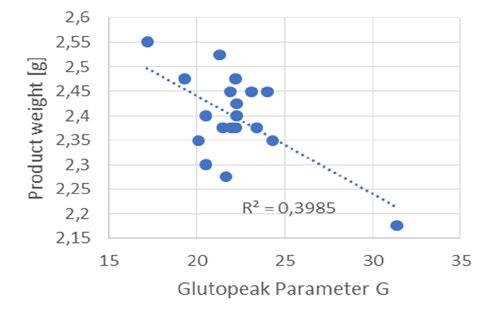
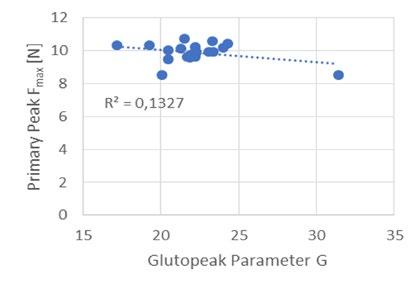
The industry leading continuous mixers from Exact Mixing offer large capacity manufacturers production rates up to 10,000 kilograms per hour while reducing manpower and other resources. Our automated technology and sustainable designs deliver significant cost savings, reduced labor and increased operational efficiencies.
To learn more about the advantages of continuous mixing at high production rates, please call (01) 610.693.5816, or visit exactmixing.com.
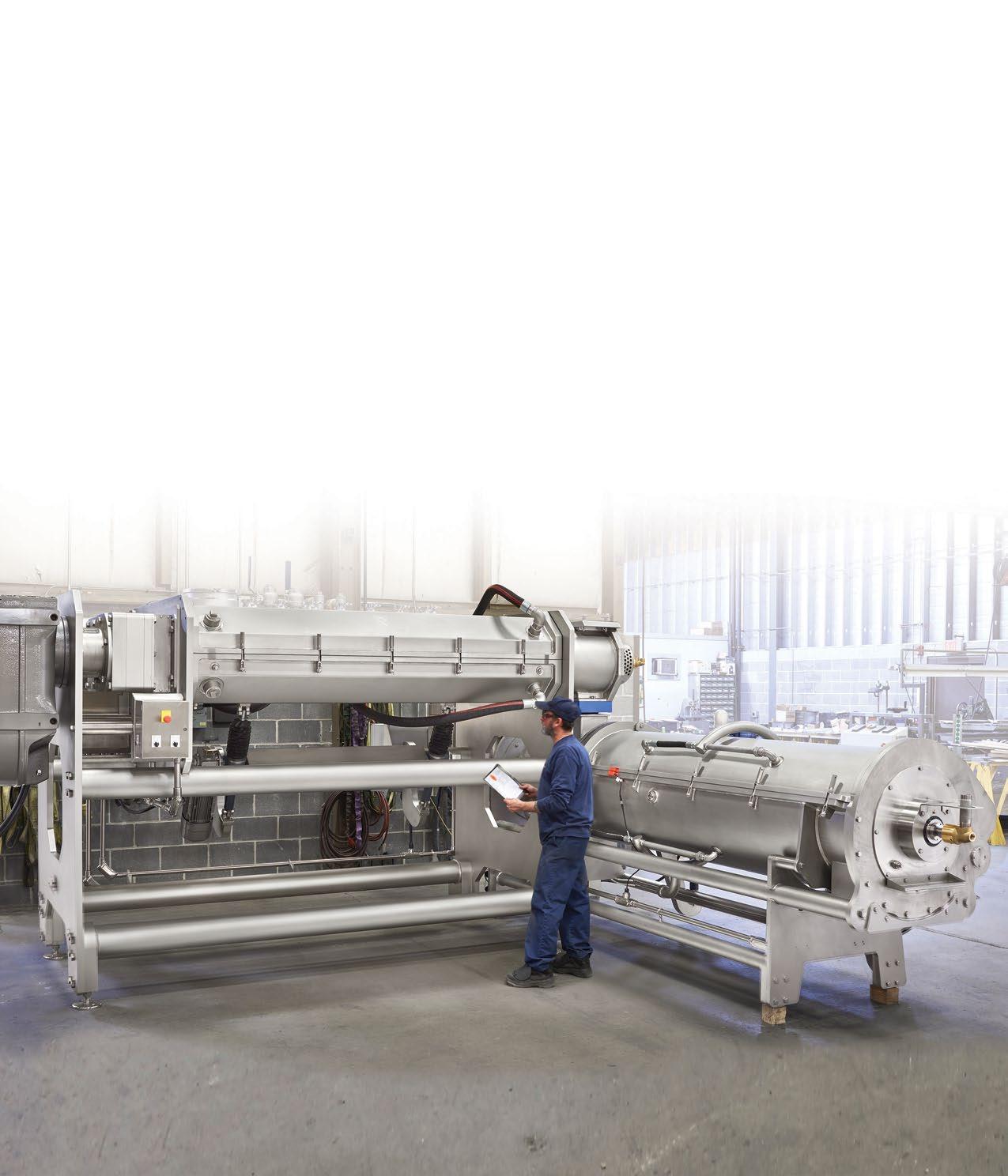






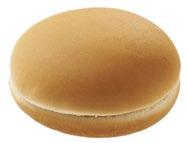


By using this modified method, data about weak flours can be assessed with a rapid method with greater accuracy in comparison to ICC methods. Contrary to the RFC method, the LPC method is verified for flours with low protein (<11%) and wet gluten content (< 25%).
Thus, the correlation of dough- or baking-relevant parameters obtained with the modified GlutoPeak method (see pic. 6 and 7) – are almost as reliable as the flour parameters obtained with ICC methods.
The basic predictions of product properties (e.g., stability) will lead to similar conclusions (see pic. 7) as this is already possible with data obtained relating to ICC-Methods. This leads to the conclusion that the ‘Low-Protein’Method of the GlutoPeak is a valuable alternative to the ICC-Methods.
Every prediction could be reproduced, in principle. This is valid for the standard laboratory analysis, as well as for the results obtained with the GlutoPeak measurements. However, the results of the Rapid Flour Check method showed only a good correlation to a certain degree with the ICC laboratory data. Water absorption particularly –a crucial factor for the characterization of waffle flours – was insufficiently displayed.
Predicting quality trends of baked waffles, aside from analyzing the flour analysis, is very difficult, as a number of further influencing factors affect the product properties. This is particularly valid when not only the raw material flour but also the baking parameters have a significant influence on the measuring data (e.g., the texture of waffle cones). Laboratory data of the baking results correlated better when acquired via ICC-Methods rather than the RFC-GlutoPeak evaluation, statistics-wise. This is due to the RFC method being specifically rather than for gluten-strong flours.
Because of that, the flours were also tested and evaluated with the newly developed Low Protein Check method,
although at the beginning of the project, this method was not yet available. The corresponding optimized LPCGlutoPeak method was modified by including the evaluation algorithm towards the ICC-standard methods and adapting the necessary parameters. Therefore, equivalent results were generated in comparison with the ICClaboratory data.
With the exception of these two flours, which did not show any peak when applying the LPC method and therefore showed no results, the tests carried out with the GlutoPeak are suitable to describe the flour quality. Due to its flexibility, easy handling, small sample quantities, and short measuring times a quick characterization of waffle flours
is achievable. The stored correlations, like wet gluten content, showed a good reference value with the obtained results, by applying the usual ICC Methods.
Based on the flour characterization provided with the LPC–Method, a quick test of much smaller flour samples for their standard suitability as waffle flour is possible, as a quick comparison of different flour batches. Furthermore, the measuring results may be used to make a quick estimation of the water needed, leading to a possible change of recipe or energy consumption. Predicting the product properties just going by flour analysis, independently from the measuring method, is not possible. +++



Product quality, industrial performance, and sustainability. At MECATHERM, we aim to support you everyday as you explore new ideas to stay ahead, and overcome challenges while reducing your carbon footprint. We are developing numerous innovative and sustainable solutions to optimize your energy efficiency throughout your entire production line. Let’s discuss and discover the array of options awaiting you.
WWW.MECATHERM.COM
Make your industrial bakery simpler

“The
Georg Heberer has been President of AIBI since 2022. In an interview with baking+biscuit international , he talks about the development of the European bakery markets during his term in office as well as the goals and future of the International Association of Plant Bakers.
+bbi: Mr. Heberer, in May 2024, the AIBI Congress in Hamburg will mark the end of your two-year term as AIBI President. It has been a challenging time economically, politically and socially for almost everyone in Europe. What were the biggest or most important problems that AIBI and you as its President had to overcome?
Georg Heberer: The successive crises and the unstable geopolitical context have seriously jeopardized the socioeconomic sustainability of the sector. Many operators are unprofitable, sometimes for long periods of time, and have been forced to reduce or close their capacities. The COVID crisis and the war in Ukraine have raised different, but equally difficult issues. The key parameters of these situations are access to raw materials, access to affordable energy, the workforce and its development, and the regulatory constraints that weigh on companies' equipment and operations. Our industry has had to develop its resilience and constantly learn to work in a changing environment. Volatility is an important part of our business today.
bbi: AIBI is made up of many national associations. The exchange of goods between countries is not the dominant factor for the companies that belong to these associations. They are heavily dependent on the conditions on their domestic markets, but are also affected by the rules and standards adopted in Brussels. In which areas was AIBI active?
Heberer: It is true that bakery is deeply rooted in national and local culture and, therefore, comprises relatively local
A partner of Wiener Feinbäckerei Heberer GmbH, Mühlheim/Germany, Georg Heberer was elected AIBI President by the association’s members at the 2022 AIBI conference in Bled, Slovenia. The term of office runs for two years as scheduled and ends with the new election at the General Assembly, which will take place in Hamburg on May 23, 2024.
businesses. However, it would be wrong to believe that such a mosaic remains the dominant aspect of our business. While some of the basic legal aspects are set at the national level – notably historical metrological aspects, the weight of bread, what it may and may not contain, etc. – a very large proportion of the regulations that govern the production, operation and fate of our products are now set at the EU level. To name just a few: safety, contaminants in raw materials, and labeling – are all governed by EU legislation.
general or specific issues, and being recognized as a responsible stakeholder in the bakery industry.
bbi: Making the interests of the industry heard in Brussels is difficult without a permanent presence there. Would that be a goal for the future of the AIBI in this regard?
Heberer: AIBI was founded in 1956 and has had a permanent office in Brussels since 2011. The AIBI office is located on the beautiful Grand Place in Brussels, in one of the city’s most famous historic buildings, the Maison des Brasseurs.
“Our industry has had to develop its resilience and constantly learn to work in a changing environment. Volatility
is an important part of our business today.”
Georg Heberer
The general policy agenda is also set at the EU level with the active involvement of Member States. The ‘Farm to Fork’ strategy and its aim to transform the food system in Europe is not a theoretical and abstract concept floating around somewhere in Brussels, but a strategic path that fundamentally influences corporate structure and strategy. Similarly, the Green Deal has stimulated an ongoing systemic transformation of our sector and its relationship with sustainability. A growing proportion of our member companies operate across borders. The exchange of products between European countries (and even beyond) is part of today's bakery business; of course, this is still relatively limited for fresh products, but packaged, bake-off and frozen products can be easily transported. AIBI is our interface and our voice on all these aspects that fundamentally influence the fate and strategy of our industry.
bbi: If an entrepreneur were to ask you today: “How does my company benefit in concrete terms?”, what would your answer be?
Heberer: You could also ask the question the other way around: “How can a modern bakery entrepreneur or a larger company function or even survive without this support?” The existence and functioning of AIBI is a shared responsibility of our industry. In an increasingly complex political and regulatory environment, the success and existence of any business or industry sector is dependent on staying on top of developments and ensuring strong and credible representation to influence them. AIBI is a focal point for information, an incubator for strategic positioning of the sector and an arm for proactive intervention with its members in potentially all areas affecting the bakery industry at the EU and national level. Membership of the AIBI network means being informed of regulatory changes before they are implemented, being consulted and involved in the drafting process where possible, having the opportunity to contribute to the strategic positioning of the sector on
For a sector that is one of the three largest food production sectors, it is, of course, of the utmost importance to have a visible and active presence at the heart of Europe and its institutions. It is the daily task of this office and its SecretaryGeneral to ensure the interface with these institutions and other stakeholders.
bbi: Networks across national and industry borders are the be-all and end-all these days. Have you and the AIBI managed to bring the baking industries of the individual member countries closer together and also form a powerful network with upstream and downstream industries? Could you perhaps give us some examples to illustrate this?
Heberer: Influencing the political and regulatory process today also often depends on ad hoc alliances with like-minded stakeholders, and it is one of AIBI’s tasks to participate in such networks. We work on an ongoing basis with the Bread Initiative, a platform that brings together industrial and artisan bakers, mills, ingredient suppliers and yeast producers; in a sense, it is at the heart of the bakery value chain. We also develop and/or participate in bilateral contacts and ad hoc platforms that are formed on regulatory issues. Recent examples include a joint initiative on sugar availability or a platform set up to address worrying developments in the availability of rodenticides, a pest control agent.
“In an increasingly complex political and regulatory environment, the success and existence of any business or industry sector is dependent on its ability to control developments and ensure strong and credible representation to influence them.”
Georg Heberer
AIBI is also a signatory/member of the EU Code of Conduct for Responsible Food Business and Marketing Practices, which is an important tool for cooperation between authorities, food processors and their upstream and downstream partners. As an association, AIBI counts the national bakery associations among its members. We are proud that, following the recent accession of the Slovakian and Polish associations, we can now count 15 such associations among our members.

bbi: Moving on to another topic, the European baked goods market, are there significant changes in the supplier structure? Are the industrial companies gaining market share in Europe and how do you assess the situation in Germany?
Heberer: The situation can vary slightly from country to country. In general, the successive crises have put the resilience of food producers to the test. Rising production costs are affecting both large bakeries and artisan producers, with large bakeries faring slightly better on average thanks to economies of scale. In conjunction with the general inflationary trend, consumers seem to be paying more attention to the price of bread and are, therefore, more likely to turn to supermarkets, where they can find fresh, quality products, now often prepared directly in-store, at a lower price. There is a perception that supermarket sales are increasing at the expense of artisan bread. Despite some volume growth, this does not necessarily mean that it will be easy for industrial bakers, as they face high production costs, fluctuations and further pressure on margins. Nor does it mean that a strategic move is being made to take over market share. In this context, it is more about putting our daily bread on the table, whether it comes from the supermarket or from an artisan baker, rather than fighting for a few points of market share. The coexistence of artisanal and industrial production is beneficial for both sides, and there is a clear awareness that both production methods must exist sustainably.
bbi: Food retailers, restaurants and delivery services often stand between the manufacturer and the end consumer. Have there been any significant changes in this field in recent years, and what impact have they had?
Heberer: I wouldn’t say that retailers and others are between producers and consumers, but they are part of a chain that goes from primary production to the bread on our tables.
If anything good has come out of the crisis, it’s probably the sense of chain and partnership, as opposed to a segmented, purely commercial relationship. I think the awareness of the need to see the supply chain as a partnership has grown. This is very evident in our thinking on sustainability, for example, where we recognize that we are clearly in the same boat and need to find the right way forward together.
“I think awareness of the need to view the supply chain as a partnership has grown. This is very evident in our thinking on sustainability, for example, where we recognize that we are clearly in the same boat and need to find the right way forward together.”
Georg Hebererbbi: The raw materials markets are a challenge for all bakeries. Suppliers are becoming larger and more international and the influence of speculators on raw material prices cannot be overlooked. Can the industry still develop freely at all and what opportunities do you see, for example in Brussels, to ensure more freedom?
Heberer: I think one of the keywords when it comes to commodities is volatility. We have seen that not only can the availability of some ingredients suddenly be called into question, but they can also be subject to significant price increases. In some cases, a short local supply chain can be a solution; in other cases, internationalization of supply and diversification of sources can help. Trust and the robustness of supplier relationships are also important. We are, perhaps, on the cusp of a paradigm shift in Europe’s socio-economic system. Together with our colleagues from the Bread Initiative, we have some ideas for the European elections and the next political cycle that follows. We see opportunities in
Our product range

Oat powders
• organic
• non-organic

Easy handling for further processing in your products, with our quickly soluble oat powders:
• For the confectionery industry (chocolate, baked goods and much more)


• In the dairy industry (desserts, drinks, ice creams and much more)




“We expect the sustainability session at the AIBI meeting in Hamburg to pave the way for a chain approach to an ambitious regenerative agriculture project.”
Georg Heberer

terms of access to raw materials, access to energy, the sustainability of our sector and labor shortages.
bbi: What consumer trends do you see in the European baked goods market?
Heberer: The entire food industry, and therefore also the bread sector, is subject to a variety of trends set by consumers. Some are only important for a short time, others last a little longer. Two things are important: our industry must react appropriately to such trends, which include growing interest in vegetarian and vegan specialties, spelt, or the desire to reduce salt. On the other hand, we must not forget that bread is and remains an undisputedly valuable staple food and is held in very high regard by customers. We must continue to deliver quality in the future!
bbi: AIBI’s community is meeting in Hamburg this year; what will be the most important topics?
Heberer: The AIBI congresses are an opportunity to take stock, address important topics and look to the future. This year’s edition, from May 22 to 24, 2024 in Hamburg, will not deviate from this practice. We have decided to structure the congress into three sessions, dedicated respectively to sustainability, the workforce challenge and digitalization, as well as an overview of international developments. We expect the sustainability session to pave the way for a chain approach to an ambitious regenerative agriculture project. In the session on labor force, we want to look at a societal and practical approach to the problem of labor availability that most sectors are facing. The international session will provide an opportunity to hear first-hand from fellow bakers from other regions. All information and registration are available until May 13, but places are limited so it is better to secure a place now.
bbi: How many guests are you expecting to attend the congress and how strong will the participation from other sectors be?
Heberer: One of the characteristics of the AIBI Congress is its relatively small and high-ranking number of participants. Compared to other business events, this favors high-quality networking. We expect around 120 participants, including representatives of the most important suppliers and downstream partners.
bbi: Your term as AIBI President is coming to an end. Do you intend to stand for re-election, or who has the best chance of becoming your successor?
Heberer: According to AIBI practice, the term of office of the incumbent President ends with the Congress. Our Articles of Association do not provide for re-election. The succession is planned in advance and we have already prepared it. The participants of the Congress will be the first to know our proposal, but, of course, we will communicate publicly shortly afterward.
bbi: Looking back, what was the most fulfilling event for you during your presidency?
Heberer: I was pleased that we were able to significantly intensify cooperation in the AIBI committees. The admission of two new members is a strong signal of the importance of our organization. That is a great result!
However, I am particularly grateful for the support I have received throughout my presidency from my vice president, Mr. Jean-Manuel Leveque. He has always been a loyal and reliable advisor at my side! Merci beaucoup!
bbi: Mr. Heberer, thank you very much for talking to us.

Our solid and perforated steel belts have helped bakeries produce premium quality products for almost 100 years.
Flat, straight, durable and easy to clean, they provide a baking surface that’s ideal for everything from rich, chewy all butter cookies to traditional biscuits and crackers.
We can also support you with a wide range of conveyor components covering everything from tensioning, drive stations and drums to tracking systems, break points and graphite stations. Talk to your local IPCO service team and we’ll work with you to improve the performance, productivity and reliability of your oven through process enhancement and system upgrades.


High productivity wide belts up to 3500 mm.
Maximum versatility – bake more on an IPCO steel belt.
Energy efficient – lighter belt means lower carbon footprint.
High power laser cleaningfaster, cleaner and greener than traditional cleaning.
Installations, upgrades (mesh replacement), repair, maintenance and spare parts.
Chocolate coating is a tasty addition to bakery goods, but it also creates challenges when handling compounds in the manufacturing process. A good understanding of the desired result and how to work with chocolate are key to a successful outcome.

+Chocolate coating requires specific handling to control its crystallization behavior in the process. Different challenges are associated with the dough, the filling and/or coating process, the chocolate tempering, and with combining bakery goods and chocolate to achieve the desired results, while also optimizing the shelf life of the products using chocolate. Moreover, when chocolate fillings are also a part of the process, specific raw materials and competencies are needed to ensure the desired consumer experience and production process.
Using a cocoa butter substitute (CBS) to create chocolate compounds can significantly reduce formulation costs for products, bakery goods included. A CBS is a fat that is used as a substitute for cocoa butter in chocolate production. They have lower costs than cocoa butter and they can provide similar properties such as texture and mouthfeel to the finished chocolate product. They usually consist of vegetable oils such as palm oil, shea butter, or coconut oil. However, most options on the market present issues with bloom – cocoa butter separating from the other components – and sensory qualities if the amount of cocoa butter exceeds 5% of the total fat content in the formulation. The fat bloom is accelerated by improper storage or product aging, and formulation issues will only accentuate it.
A solution that can help with this challenge is the CEBES ™ Choco 15 – a patented compound vegetable fat recently designed by Swedish specialist AAK to be used for the chocolate-like components in bakery goods. It was among the finalists in the Sensory Innovation Award at Food ingredients Europe 2023, where it was introduced.
When mixed with other coating ingredients, CEBES ™ Choco 15 eliminates the necessity for tempering. Once mixed, the baked goods can be easily coated with the coating quickly setting so it can be sent to packaging.
This plant-based CBS compound increases cocoa butter tolerance from 5% to 15%, which helps deliver an enhanced cocoa flavor. It supports a long shelf life and helps avoid bloom even in recipes with a high ratio of cocoa, ensuring that products retain a glossy appearance, remain hard, are stable at room temperature, and are pleasant to the touch. In addition, it is free from trans-fatty acids (TFAs) and has cost-efficient processing, with no tempering process required, while maintaining a fast setting time.
Market trends indicate that affordable indulgence will be essential in a recessionary environment, with consumers increasingly seeking out high-quality treats at more modest prices. CEBES ™ Choco 15 is a cost-effective solution that is designed to help brands deliver a more authentic chocolate experience across a broad array of products.
The women’s group supply chain Kolo Nafaso now engages almost 300,000 women. Since 2009, the program has been focusing on poverty alleviation and women empowerment through direct trade, interest-free micro-credits, and training of shea-collecting women in West Africa.
Women have the power to decide to whom to sell their kernels, but Kolo Nafaso offers a long-term partnership with a buying guarantee.
Next to pre-financing and training, Kolo Nafaso also offers:
+ A fully ethical and transparent business relationship
+ Freedom for women to do business and a buying guarantee
+ Training in better processing and business practices
+ A fully segregated and traceable supply chain
In addition to the traditional shea supply chain, AAK sources shea from Kolo Nafaso.
Innovation in product development favors unusual combinations and new experiences. In the world of ‘ChocoBakery’, this means hybrid products are created where chocolate adds something to a sweet bakery application, and vice-versa. Beyond just chocolate cake and biscuits, it’s all about decadent, indulgent treats in innovative snacking formats, often co-branded to leverage trusted, salient brands. AAK observes: “Chocolate adds sophisticated sensory appeal to bakery items; in turn, the bakery segment brings variety and novel textures to chocolate offerings. It also adds aesthetic appeal, driving engagement on social media. We’re certainly aware that cross-products have been around for a long time, but things are happening in the crossing between the chocolate and bakery industries. Analysis of new chocolate confectionery launches in 2022 reveals a preference for the crunch texture, constituting 15% of these introductions. Additionally, 20% of recently released packaged sweet bakery products now incorporate chocolate. This suggests a growing trend of industry consolidation, fortifying the overall landscape of both the chocolate and bakery sectors.”

A diverse range of solutions can provide options to achieve various product claims. For instance, AAK’s specialty cocoa butter, COBAO ™ Pure, is UTZ certified – it can be used to create vegan chocolate with a clean label by eliminating milk fat. In the realm of compound products, AAK provides solutions that eliminate the need for labeling hydrogenation and trans fatty acids.




The company’s CBE range also allows for an RSPO-certified palm claim and is offered as Kolo Nafaso shea. Going beyond the conventional shea supply chain, AAK sources shea directly from women's groups through the Kolo Nafaso supply chain, which focuses on poverty alleviation and women empowerment. This program involves direct trade, interest-free micro-credits, and training for sheacollecting women in West Africa.
Sustainability concerns determine the recipe for success in chocolate products, too. Category cross-overs such as ChocoBakery creations make indulgence affordable while being mindful of the supply chain with the use of plantbased ingredients that were not cultivated on lands victim to deforestation. And, always a determining factor, these innovative products can taste great.
As the world navigates cocoa prices reaching unprecedented peaks, such treats need not disappear from moments of indulgence. Given the surge of more than 90% in cocoa butter prices over the last five years, and with expectations of continued increases in the future, transitioning to cocoa butter equivalents (CBEs) offers an opportunity for cost savings, while still meeting consumer expectations regarding taste and affordability.

AAK explains: “Incorporating CBEs into your chocolate recipes not only results in cost efficiency but also enhances the snap and texture of the chocolate, extending the product's shelf life. This combination enables tailored indulgence and opens up new avenues for chocolate


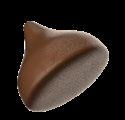
“Chocolate adds sophisticated sensory appeal to bakery items; in turn, the bakery segment brings variety and novel textures to chocolate offerings.”
AAK specialists
innovation. By incorporating 5% or less of CBEs, your product can still bear the label of chocolate.“
The CEBES™ Choco 15 compound can also maintain product quality and control production costs, as this CBS is TFA-free and has cost-efficient processing, with no tempering necessary, while maintaining a fast setting time.
To target the premium product segment, while keeping offerings available, optimization strategies vary depending on the market and target consumer groups. “To ensure the selection of the most suitable solution, we employ our co-development approach. Examples of innovative and cost-effective/high-quality indulgences might include bakery goods covered with chocolate or chocolate-like coatings, chocolates filled with crunchy cookies, and collaborative branding ventures,” AAK specialists weigh in.
AAK co-develops custom chocolate solutions together with manufacturers, considering variables that include market differentiation, product functionality, health, product quality, product profitability, higher efficiency, and sustainable solutions - from test set-up to full-scale production.
The company recently conducted a global consumer survey on chocolate motivations, which showed that taste consistently emerges as the primary driver for purchase across all researched countries. Additionally, the study highlighted affordability as a significant purchase factor, although taste still reigns supreme, outranking other considerations. +++

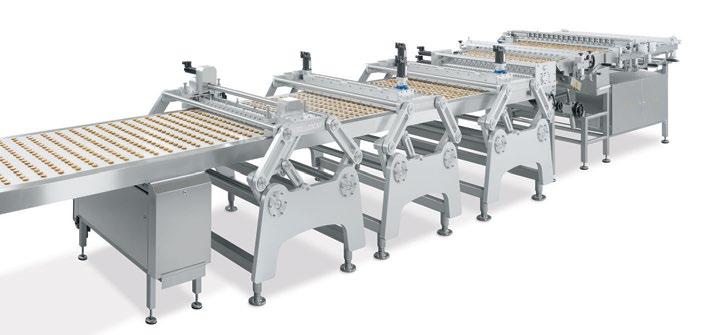
Among the analytical possibilities available for characterizing food products, microscopy is only seldomly used by industrial companies. This is a pity! Microscopy allows fascinating insights into the inner structure of foods, helping to understand the mechanisms that contribute to product quality.
 By Frida Köning and Dr. Julien Huen, ttz Bremerhaven
By Frida Köning and Dr. Julien Huen, ttz Bremerhaven
Food products represent a complex mixture of proteins, carbohydrates, fats, water and micronutrients, sometimes also gases and microorganisms. In most cases, these constituents are not evenly and homogenously distributed, but form structures in space. These structures may originate from the raw materials, like starch granules that can be found in wheat grains, wheat flours and wheat dough (figures 3, 4, 5 and 6), or be created by processing like gluten network in wheat dough or fat layers in puff pastry (figure 6).
Microstructure is important for several reasons. Firstly, it has a strong influence on the rheological properties of the foods. The 3-dimensional gluten network, for instance, holds the different components of the dough together and is responsible for its elastic properties. Secondly, the fact that some constituents form agglomerates in the product limit their surface of contact with the other components and their possibility of interaction. At room temperature, amylose and amylopectin as components of starch granules are only to a limited extent accessible to the action of amylases. Thirdly, microstructure also influences the tendency of the different phases to separate over process and storage: emulsions may break and gas bubbles escape from the product matrix.
All in all, microstructure is the basement on which most product properties are built. Therefore, making it visible and understanding how to influence it has great potential for improving and maintaining product quality.
The simplest equipment available for microscopy consists of a brightfield light microscope. White light from a light source like a mercury lamp goes through a thin section. A combination of lenses creates a magnified picture of the sample, either in the eye of the observer or on the sensor

of a digital camera. It allows viewing the sample with real colors. Dyes binding specifically to certain components of the sample may be used, making those components appear in defined colors (e.g. violet staining of starch with iodine). The main limitation of brightfield microscopy is its resolution.
A more sophisticated optical technique is confocal microscopy, often combined with the use of fluorescent dyes. The main differences to brightfield microscopy are: (1) Monochromatic laser light is used as a light source. (2) The image is acquired point by point (pixel by pixel) with a special scanning technique. This means that the laser light is focused on one single point of the sample, at which it is partially absorbed by the dye. Due to its fluorescent properties, the dye will emit light at a higher wavelength than the laser. The intensity of this fluorescence signal is measured by a detector and is, to a certain extent, proportional to the concentration of the dye at the measured point. (3) On its way to the detector, the fluorescent light goes through a

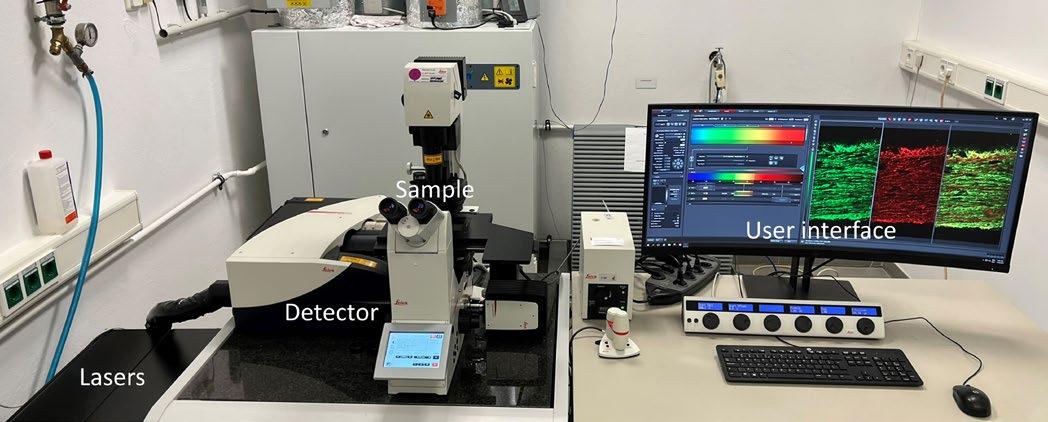
small opening called a pinhole, which is positioned in the optical path in such a way that light coming from layers below and above the measured point is absorbed. This makes sure that only signals coming from a very thin layer of the sample is measured, increasing Z-resolution. With confocal microscopy, very sharp images with a side (X/Y) resolution of down to 125 µm and a Z resolution of around 500 µm can be acquired. By using several fluorescent dyes binding to different components of the sample, it is possible to acquire images showing the spatial distribution of the main components of the sample, in two or three dimensions.
In confocal microscopy, an alternative to the use of fluorescent dyes is Raman spectroscopy. Instead of a fluorescent signal, a Raman spectrum is measured at each point of the sample in the investigated area. This spectrum represents
“Lots of exciting possibilities exist at different levels to further improve the quality of microscope pictures and the possibilities of their interpretation in relation to product quality and process design.”
ttz Bremerhaven specialists
a fingerprint of the molecular composition of the sample at the measured point. Therefore, there is no need to select appropriate fluorescent dyes, nor to stain the sample prior to measurement. A limitation of the first Raman microscopes was, however, the long acquisition times of the images, due to the very low intensity of the Raman signal. This difficulty is however partially overcome by systems of











Sourdough starter made of naturally cultured microorganisms. Global use – reliable for all processes – ideal for mild baked goods!


wheat grain, stained with FITC, Rhodamine B and Nile blue. (a) Overview of the structure, showing the lipid-rich germ (embryo) on the top, the fiber-rich pericarp (bran) all around and the starch- and protein-rich endosperm on the left and the right. The dark areas on the right/bottom are artifacts due to imperfect cutting, resulting in some parts of the sample being slightly out of focus (b) Detail of the pericarp and the starchy endosperm. The starch granules can be recognized in green, while the protein (mainly gluten) appears in beige/red.
the newest generation, which are still very expensive but have promising potential.
An alternative to optical microscopy is scanning electron microscopy, which has the advantage of even higher resolution, but the inconvenience of complex sample preparation and the absence of information on the composition of the observed structures (no specific staining, black and white pictures).
At the end of 2018, ttz Bremerhaven decided to invest in a piece of high-end microscopy equipment. The choice made was a confocal laser scanning microscope, mainly because of the speed of measurement, the picture resolution and the relatively low amount of sample preparation necessary.
Figure 2 shows an overview of the system. Light for fluorescence excitation is provided at four different wavelengths by four lasers. The laser light is guided to the microscope by optical fibers, where it is focused on the point of the sample to be measured by a series of optical components. The emitted fluorescent light is captured by the same optical elements, and then led to detectors that measure its intensity in defined wavelength ranges. A computer system transforms the fluorescence intensity data originating from the different points of the investigated sample area into images. When several fluorescent dyes are used simultaneously, with different binding specificities (e.g. one dye for carbohydrates, one for proteins and one for fat) and different absorption and emission wavelengths, it is possible to create a picture of the sample showing the distribution of the different components in different colors.
©
A typical sample preparation and measurement workflow includes cutting at the cryostat microtome (figure 1) followed by staining with a fluorescent dye solution, transferring in a microscopy petri dish and measuring (figure 2). Figures 3 to 6 show how microstructure evolves over processing, from a wheat grain over wheat flour to a commercial puff pastry dough. At all steps, the starch granules are clearly visible (shown in green on the pictures, sometimes appearing as black spheres if the dye does not penetrate well into them). They are located in the starchy endosperm of the wheat grain, form agglomerates with proteins in the flour, and are still visible in the laminated puff pastry dough. One interesting observation in Figure 6b is that the dough and fat layers are so thin that the starch granules are partly pressed into the fat, which tends to damage its structure. Based on the assumption that intact, continuous layers of dough and fat are necessary to allow a good puffing effect, it can be hypothesized that a lower degree of folding and sheeting may lead to better baking results.
Lots of exciting possibilities exist at different levels to further improve the quality of microscope pictures and the possibilities of their interpretation in relation to product quality and process design. Fluorescent dyes with a higher specificity can be used in order to be able to differentiate between the components of the samples in a finer way (for example to distinguish between different types of proteins). This can be achieved for instance by the use of specific antibodies. Alternatively, measuring Raman spectra allow a very specific chemical differentiation.
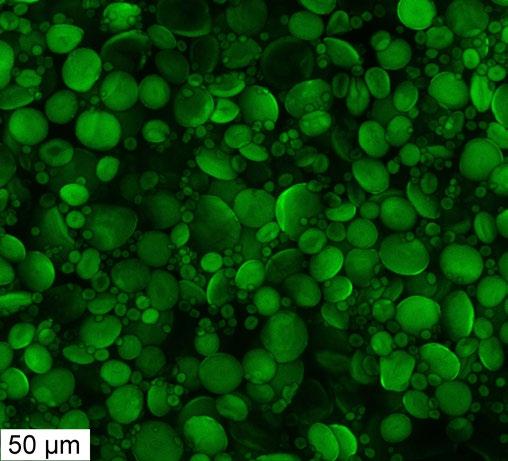

a)

b)
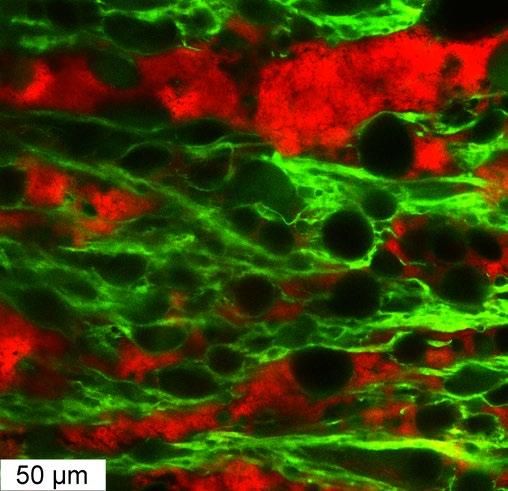

Making CLSM measurements over time (picture series), at constant or varying temperatures, has the potential to reveal time-dependent changes occurring in a food process. ttz Bremerhaven also works on the integration of polarization and fluorescence microscopy in one system, permitting to distinguish crystalline from non-crystalline areas. This is especially interesting for investigating starch retrogradation or fat crystallization.
Another promising approach is image processing with a view to calculating data describing the pictures: For instance,
MULTIVAC acquired land in the new Industrial Park in Iphofen, Germany, where FRITSCH will relocate its main headquarters. The new location, spanning 7.6 ha of land, will bring together the business operations of the dough machinery manufacturer, which are now spread over five locations in Kitzingen and Markt Einersheim. Construction is scheduled to start at the end of 2025, and the relocation to the new site is planned for the third quarter of 2027.
The new building complex with a total area of approximately 20,000 square meters will accommodate production halls and assembly facilities, which will be equipped with the latest technology. The World of Bakery, FRITSCH’s Technology Center, will also be relocated to the new site. New offices and social facilities are assigned around 5,000 square meters, for the FRSTICH team comprising 480 staff members.
“As part of a sustainable infrastructure for the MULTIVAC Group’s new building, there are also several measures planned for the new company site to reduce greenhouse
the number of starch granules in a certain volume and their size distribution, or the surface of contact between two phases. This will allow comparing pictures in an objective way and making statistical evaluations of the significance of differences.
From the point of view of product and process optimization, the potential of microscopy is used in the best way when connecting microscope data with other relevant product and process data. This allows to understand mechanisms at the origin of desired product properties and to steer processing accordingly. +++

gas emissions. We want to use groundwater to heat and cool the building complex. We also want to use as much self-generated energy as possible for the energy supply with a photovoltaic system and a combined heat and power unit,” explains Christian Traumann, Group President (CEO) of the MULTIVAC Group. +++

Dawn Foods takes inspiration from European-style chocolate, taking its interpretation across the Atlantic Ocean, with a new offering for the North American market that bridges chocolate-tasting experiences.
+In February 2024, Dawn Foods North America launched its newest chocolate creation, part of its Chocolate Mania portfolio: the Dawn Exceptional® European Style Chocolate Buttercreme, combining premium ingredients.
How did Dawn define the European-style chocolate creation? It boasts a “decadent and fudgy texture”, and a dark chocolate flavor for enhanced taste and aroma. It is smooth enough for easy decorating, yet firm enough to hold designs. The Chocolate Buttercreme is made with real cocoa, which meets the demand of an overwhelming 91% of consumers, a survey by Mintel survey on dessert ingredients found. On the technical side, Dawn ensured that it can be used to achieve consistent results when used by professionals and all chocolate enthusiasts. A reminiscent of buttercreams made from scratch, it was developed to be easy to use. Its development was inspired by Dawn’s market research findings: “Backed by insights from a recent survey, our new Euro Style Chocolate Buttercreme prioritizes rich flavor and texture, supported by seamless functionality,” said Allison Hornev, Sr. Director Marketing Core Portfolio & Innovation. Packaged in a rounded square pail developed by Dawn, this icing is designed for easier handling and storage efficiency, catering to bakeries of all sizes. Chocolate buttercream was found to reign as the preferred frosting flavor.
And why is chocolate buttercream the European chocolate flair of choice, for an North American offering? According to Dawn’s research i, it is an undisputed favorite among frosting flavors on the NA market, with 89% of the consumers surveyed indicating they were likely to buy a cake with Chocolate Buttercreme frosting on their next cake purchase. Chocolate of any shape or form has the potential to drive up to a 10% increase in dollar growth, Nielsen Byzzer’s research also highlights. Even rising prices do not deter
“Backed by insights from a recent survey, our new Euro Style Chocolate Buttercreme prioritizes rich flavor and texture, supported by seamless functionality.”
Allison Hornev, Sr. Director Marketing Core Portfolio
Innovation, Dawn Foods
consumers from buying chocolate products. For example, chocolate sales rose by 5.8% in the US in 2023 to almost USD 26 billion, according to a Bloomberg report. The studies reflect consumers‘ unyielding interest in chocolate and matching opportunities for bakeries to create more of their favorites, in creative interpretations.
Chocolate’s soaring popularity spells opportunity for bakeries. Dawn’s ‘Chocolate Inspiration Guide’, created for the North American market, can be a source of new recipe ideas. It highlights trending product ranges, including cakes, cupcakes, pies, tarts, brownies, cookies, donuts, muffins and pancakes.
“We're committed to making chocolate the star of your bakery case. Our Chocolate Mania Inspiration Guide features a variety of recipes, including Death by Chocolate Cake and Dark Chocolate Raspberry Tart, to help unleash your creativity,” said Melissa Trimmer, Corporate Executive Chef and Director of Culinary & Innovation Studio.
Ideas and solutions are available to spark the creativity and curiosity of bakers as well as consumers. Dawn provides resources for inspiration and solutions, on www.DawnFoods.com. +++

Spelt has been making a comeback among consumers’ favorites, propelled by scientific evidence and the perception that it offers greater nutritional benefits compared to common wheat.
By Dimitris Argyriou+Spelt (Triticum spelta L., also known as T. aestivum ssp. spelta) is a primitive hulled wheat species that has been cultivated since around 7000–8000 BCE. It served as a staple food across Europe from the Bronze Age through medieval times. However, its cultivation declined following the introduction of the potato to Europe and the rise of high-yield, huskless varieties of common wheat (Triticum aestivum L., or T. aestivum ssp. aestivum) that are simpler and more cost-effective to process. Despite this, spelt has continued to be an important food and minor cereal crop in certain areas of central Europe, such as Belgium, Germany, Austria, Slovenia, and Northern Italy, and also in Canada and the USA.
In the past two decades, there has been a resurgence in the demand for spelt wheat, with expectations of a continued annual increase of about 5%. This renewed interest is attributed partly to consumer beliefs and a growing body of scientific research suggesting that spelt wheat offers greater nutritional benefits than common wheat and boasts robust characteristics, such as high disease resistance, making it well-suited for organic agriculture, which is on the rise worldwide. This demand has led to the expansion of both conventional and organic spelt cultivation into new regions, including those with semi-arid Mediterranean climates.
There are notable differences between spelt and common wheat. Spelt plants are taller, with elongated, loose ears, brittle rachis, and tightly adhering glumes. The grain is harvested with its hull, necessitating an expensive dehulling process before milling. Spelt flour typically yields about 65% due to the robustness of the spelt hull, making it harder
to process than contemporary wheat and rye varieties. However, the hull serves as a natural barrier against pollutants and pests, preserving the grain’s nutrient content and freshness. Despite its benefits, the smaller yield per area and the mandatory dehulling process contribute to spelt’s higher cost compared to common wheat.
Spelt wheat is recognized for its high nutritional value, providing all essential components needed by humans. The nutrient content can vary depending on the cultivation conditions, including location, season, and fertilization practices. Spelt’s nutritional benefits stem from its rich protein, lipid, crude fiber, vitamin, and mineral content of the aleurone layer in its kernel compared to common bread wheat.
Starch, the primary storage carbohydrate in plants, shows a broad range in content across spelt cultivars, with some studies suggesting spelt products could be more rapidly digestible. Spelt flours have been found to contain fewer reducing sugars compared to flour from common wheat, affecting the nutritional profile of bread made from these flours.
The fiber content in spelt varies, with a notable portion of soluble fiber, which has distinct physiological benefits. Spelt also exhibits a low β -glucan content, similar to common wheat. The lipid profile of spelt is complex, with findings suggesting higher lipid and unsaturated fatty acid content in spelt compared to wheat, potentially due to a greater germ presence or differences in the aleurone layer.
Vitamin content in spelt, particularly B vitamins and fatsoluble vitamins, does not significantly differ from that of common wheat, though some spelt cultivars have shown higher levels of certain nutrients. Ash content, indicative of mineral content, is higher in spelt, reflecting its richer macro- and microelement profile compared to wheat. This nutritional composition contributes to spelt's proposed benefits in alternative medicine treatments, despite its gluten content, which makes it unsuitable for individuals with celiac disease or gluten sensitivity.
Spelt contains higher protein levels and a more significant portion of the aleurone layer in its kernel compared to common bread wheat. Furthermore, spelt differs from wheat in the amount and type of grain proteins, especially of prolamines. This may be the reason why some people with food allergies are able to tolerate foods containing spelt flour. Protein content in spelt can fluctuate based on the cultivar and agricultural practices.
The major protein fraction in wheat, gluten proteins, play a critical role in wheat’s distinctive properties among cereals, affecting the baking quality through wet gluten yield and spreadability. Spelt tends to produce a higher yield of wet gluten and exhibits a more spreadable, albeit weaker, gluten structure. This variability in wet gluten content among spelt cultivars could be influenced by the specific cultivar characteristics and nitrogen fertilizer application levels.
The distinction between spelt and common wheat extends deeply into their respective gluten compositions, markedly influencing their utility in breadmaking. Spelt is characterized by a unique proportion of glutenin and gliadin proteins, the two primary components of gluten that determine the elasticity and extensibility of dough. Glutenin is known for providing strength and elasticity, whereas gliadin contributes to the dough’s extensibility and fluidity. The specific balance between these proteins in spelt results in a dough with differing rheological (physical and mechanical) properties (Table 1) compared to that made from common wheat.
This difference in gluten composition is crucial because the dough’s ability to stretch and retain gas produced during fermentation is fundamental to its volume and texture. In spelt, the altered gluten-protein ratio may lead to challenges in achieving the optimal dough structure necessary for highquality breadmaking. This is because the gluten network in spelt dough can be less developed than in wheat, affecting the dough’s gas retention capacity and, consequently, the bread’s rise and crumb structure.
The impact of spelt’s unique gluten composition on breadmaking performance is significant. While common wheat
typically produces dough with strong, elastic gluten networks, ideal for producing well-risen, airy bread, spelt’s gluten structure often results in bread with a denser texture and lower volume. This is considered one of the primary reasons for spelt’s inferior breadmaking performance relative to common wheat. However, it’s also worth noting that these characteristics of spelt can be advantageous for certain types of baked goods, where a denser crumb is desirable.
2.5 Antinutritional elements
Spelt grains, along with other types of cereal grains, contain antinutritional elements such as alkylresorcinols, tannins, and trypsin inhibitors. Variations exist in the concentration of alkylresorcinols among different spelt varieties, but on average, spelt has a lower concentration (395 mg/kg) compared to wheat (475 mg/kg). Similarly, the overall tannin content in spelt (1.96 g) is roughly equivalent to that in wheat (2.02 g), whereas the activity of trypsin inhibitors in spelt (0.96–1.11 TIU/ mg) is generally lower than that found in wheat (1.28 TIU/mg).
3. Baking applications
3.1 Technological adjustments and improvers
Mixing spelt with wheat flours can enhance baking quality, offering a solution to spelt’s inherent challenges in dough
“Spelt’s application extends to nutrition bars, breakfast cereals, sourdough bread, biscuits, cookies, muffins, and prebiotic wafer crackers, showcasing its adaptability in food manufacturing.”
Dimitris Agryriou, Food Scientist, Managing Director, Grainar
handling due to its soft and sticky nature after kneading. Despite these challenges, spelt flour contributes to a distinctively strong bread aroma, superior taste, and extended freshness and softness of the bread.
In baking experiments, the impact of dough strengtheners such as ascorbic acid (ASC), glucose oxidase (GOx), and transglutaminase (TG) on spelt dough was assessed. ASC and GOx enhance dough strength by forming disulfide bonds in gluten proteins, whereas TG strengthens dough by creating covalent bonds, benefiting dough elasticity despite spelt’s low lysine content. While these improvers are known to enhance low-quality wheat dough, their effects on spelt – a wheat variant with a unique protein composition – were notable in improving baking qualities such as volume, crumb firmness, and color.
Baking experiments have demonstrated that incorporating specific enzymes, particularly xylanases and lipases, into spelt dough formulations leads to significant improvements. These enzymes are central components of many commercial dough improvers, chosen for their ability to enhance the dough’s characteristics and final bread quality. Xylanases break down the xylan chains in flour, improving dough handling and volume, while lipases modify the lipid content, enhancing dough stability and gas retention.
In addition to these enzymes, the use of hydrocolloids like guar gum and xanthan gum has proven beneficial for spelt flour’s baking properties. These hydrocolloids are known for their water-binding capabilities, which increase the water absorption of the dough, leading to a moister crumb and extended shelf life. Furthermore, guar gum and xanthan gum contribute to the freshness retention of baked goods by stabilizing the structure and preventing staling, thereby improving the overall sensory qualities of spelt-based breads and pastries. This combination of enzymes and hydrocolloids offers a comprehensive approach to optimizing spelt flour’s performance in baking applications, targeting both the improvement of dough processing and the enhancement of the final product's quality.
3.2 Spelt in breads, traditional specialties and more Spelt wheat exhibits considerable versatility in its applications, ranging from animal feed to various human food products such as flour, bread, breakfast cereals, pasta, crackers, and regional specialties like the Grünkern from Southern Germany. Grünkern, harvested while the spelt is still green and then dried, is known for its smoky aroma and is traditionally used in various dishes. Spelt flour, often found in health-food stores, commands a premium price due to its nutritional and culinary value. In the United States, spelt flour and its derivative products such as bread and pasta are gaining popularity and are marketed for their unique qualities.

Spelt specialty breads, like the Oberschwäbische Seelen from Southern Germany, are prized for their unique shapes, textures, and flavors, often enhanced with salt and caraway seeds.
In pasta production, spelt flour’s suitability largely depends on its protein content. With adequate protein levels and high drying temperatures, spelt flour can produce pasta with satisfactory cooking qualities. Adjustments, such as the addition of vital gluten, can enhance the pasta-making potential of spelt flour with lower protein content. Consumer acceptance of spelt pasta’s color and texture, especially









within the whole meal, health, or organic food sectors, indicates flexibility towards non-traditional pasta appearances.
Furthermore, spelt’s application extends to nutrition bars, breakfast cereals, sourdough bread, biscuits, cookies, muffins, and prebiotic wafer crackers, showcasing its adaptability in food manufacturing. These applications underscore spelt’s potential for producing high-quality food products, contingent upon selecting the appropriate cultivar and optimizing processing conditions.
The potential for expanding spelt cultivation significantly hinges on its applicability in creating a variety of products, including pasta and flakes, which are notable for their appealing taste and nutritional benefits. Spelt wheat, along with its derivatives, is identified as a rich source of protein
References:
1. Sousa, T.; Ribeire, M.; Sabenca, C.; Igrejas, G. The 10,000-year success story of wheat. Foods 2021, 10, 2124. [PubMed
2. Zohary, D.; Hopf, M.; Weiss, E. Domestication of Plants in the Old World: The Origin and Spread of Domesticated Plants in Southwest Asia, Europe, and the Mediterranean Basin; Oxford University Press on Demand: Oxford, UK, 2012.
3. Frakolaki, G.; Giannou, V.; Topakas, E.; Tzia, C. Chemical characterization and breadmaking potential of spelt versus wheat flour. J. Cereal Sci. 2018, 79, 50–56.
4. Koenig, A.; Konitzer, K.; Wieser, H.; Koehler, P. Classification of spelt cultivars
and is distinguished by its high content of soluble fiber in its final product. With a growing consumer focus on health and a better understanding of how diet affects overall well-being, spelt wheat is poised to become more popular and sought-after. +++
Managing Director at Grainar, Dimitris Agryriou is a team leader and scientist in product and service development for the bakery and milling industry. In his work, he explores the latest developments in biotechnology, cereal chemistry and industrial analytics. He is a subject matter expert on bringing improver performance with rheology and baking with the help of analytics. Contact: dargyriou@grainar.com
based on differences in storage protein compositions from wheat. Food Chem. 2015, 168, 176–182.
5. Skrabanja, V.; Kovac, B.; Golob, T.; Liljeberg Elmstahl, H.G.M.; Bjorck, I.M.E.; Kreft, I. Effect of spelt wheat flour and kernel on bread composition and nutritional characteristics. J. Agric. Food Chem. 2001, 49, 497–500
6. Marconi, E.; Carcea, M.; Graziano, M.; Cubadda, R. Kernel properties and pasta-making quality of five European spelt wheat (Triticum spelta L.) cultivars. Cereal Chem. 1999, 76, 25–29.
ADVERTISER DIRECTORY
baking+biscuit international is published six times a year.
Single copies may be purchased for EUR 15. Subscription rates are EUR 75 per annum. Students (with valid certification of student status): EUR 40. (All rates include postage and handling, but not VAT).
Cancellation of subscription must be presented three months prior to the end of the subscription period in writing to the publishing company. Address subscriptions to the above stated distribution department.
Claims will not be accepted for any copies not received or lost copies due to reasons being outside the responsibility of the publishing company. This magazine, including all articles and illustrations, is copyright protected. Any utilization beyond the tight limit set by the copyright act is subject to the publisher’s approval.
Online dispute resolution in accordance with Article 14 Para. 1 of the ODR-VO (European Online Dispute Resolution Regulation): The European Commission provides a platform for Online Dispute Resolution (OS), which you can find at http://ec.europa.eu/consumers/odr
Valid advertising price list: 2024
PUBLISHING HOUSE
Food2Multimedia GmbH Schoolkoppel 27 21449 Radbruch, Germany +49 4178 244 9797 www.foodmultimedia.de
EDITOR EMERITUS
Hildegard M. Keil hildegard_keil@t-online.de
PUBLISHER
James Dirk Dixon dixon@foodmultimedia.de
EDITOR-IN-CHIEF
Catalina Mihu mihu@foodmultimedia.de
EDITOR
Helga Baumfalk baumfalk@foodmultimedia.de
COPY EDITOR
Annie Dixon annie.dixon@foodmultimedia.de
SUBSCRIPTIONS
Viktoria Usanova usanova@foodmultimedia.de
DISTRIBUTION vertrieb@foodmultimedia.de
ADVERTISING
Dirk Dixon dixon@foodmultimedia.de
SOCIAL MEDIA
Annie Dixon annie.dixon@foodmultimedia.de
LAYOUT/GRAPHIC DESIGN
LANDMAGD Design aus der Heide
Linda
, design@landmagd.de PRINT

From a distance, you get a clear picture of the challenges and opportunities. If the Sky would be the the Limit, then what comes next? After more than three decades of specialized development and production in the bakery market, we have learned there is always more to discover and continuous room for innovative improvement. Together with our pioneering clients we are able to find solutions for challenges and individual requirements which can not be met with standard options. Looking and thinking beyond the limits we think the sky might set us, we discover ‘new worlds’. Technology based on aerospace knowledge sets new boundaries bringing us opportunities such as Vacuum Cooling and Baking. The advantages are numerous. The Sky is just not the Limit. Will you join us on the journey to the bakery of the future? Together we will find solutions for generations to come.
Verhoeven Bakery Equipment Family has a long and successful history of tailor-made development, engineering and production for the food industry. In the bakery market the family labels have established a strong position due to innovative and creative turnkey solutions. We sell high-end production lines and state-of-the-art machines. Developed and made by a wonderful team of dedicated people. This makes us proud. We would love to show you why! we










